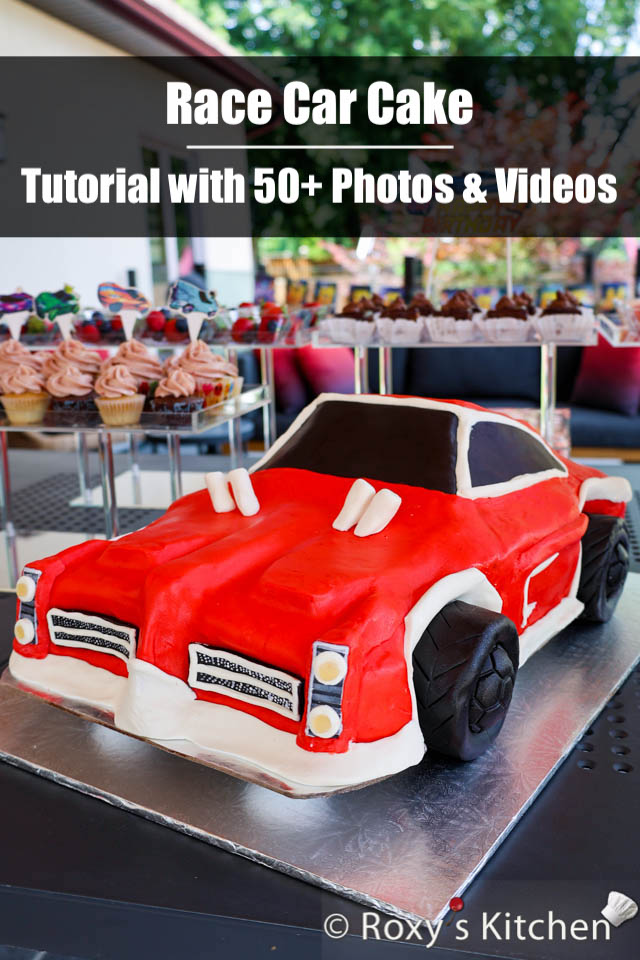
In this post, I’ll show you how to make a Race Car Cake. My kids are Rocket League fans so this year I threw race car-themed birthday parties for them. I made them two race car cakes to go along with the theme, cupcakes, race car-themed cakesicles and other desserts.
Make sure to check out my posts from this Birthday Party for Rocket League Fans series to see lots of dessert ideas, party games, snacks, decorations and much more!
Ingredients & Recipes
The amount of ingredients you need depends on the size of your race car cake. Mine was 28 cm x 43 cm (11’’ x 17’’) and 19 cm (7.5’’) tall.
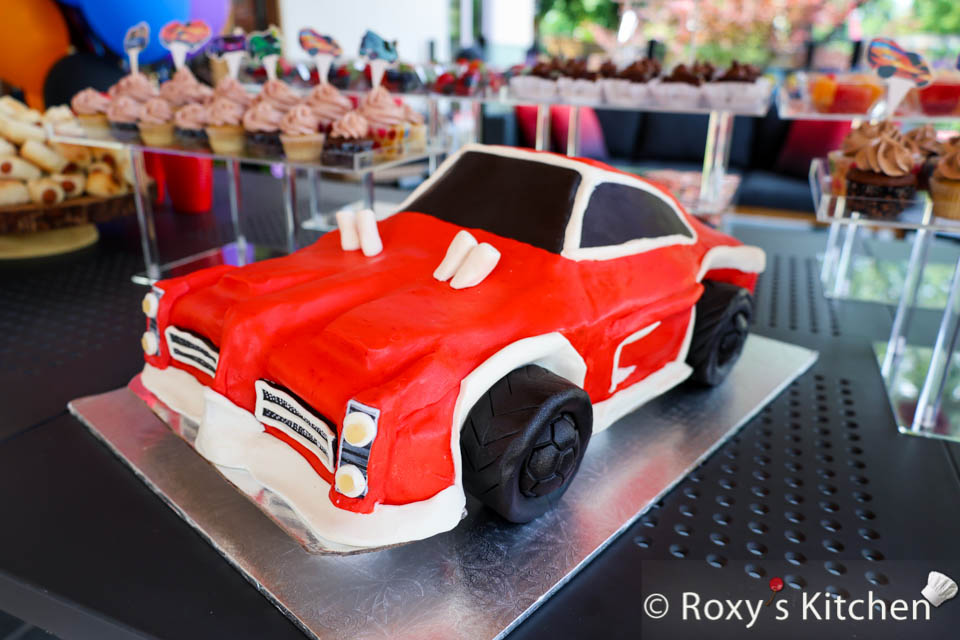
What you need for this cake size:
- Two sheet cakes, one that is 38 cm x 38 cm (15’’ x 15’’) and then second one that is 30 cm x 30 cm (12’’ x 12’’). I made my Most Vanilla Cake which is great for stacking and carving; just double the ingredients in this recipe and split the batter between the two cake pans.
- Frosting of your choice. For the filling I used Raspberry Cream Cheese Buttercream and 1 kg (2.2 lbs) fresh raspberries; double the ingredients in this recipe. Note that instead of the raspberry jam mentioned in the original recipe, I used 2 tablespoons of freeze dried raspberries. I covered the cake with semi-sweet chocolate ganache (unwhipped/firm frosting) made out of 1 kg of semi-sweet chocolate (baking or couverture chocolate) and 500 ml whipping cream. Follow the instructions in this post to make the ganache.
- Sugar syrup to moisten the cake (optional, if you want your cake extra moist). Boil the 800 ml (3.5 cups) water with 20 tablespoons of sugar. When it starts boiling, add 8 tablespoons of vanilla extract and a few drops of strawberry-flavoured baking oil. Remove from the heat and let it cool off.
- Modeling chocolate to cover the cake:
- 2.3 kg (5 lbs) of red modeling chocolate
- 1.5 kg (3 lbs) of black modeling chocolate
- 500 g (1 lb) of white modeling chocolate
Note that you can use fondant too but it dries out faster and it’s not as easy to hide the seams as it is with modeling chocolate.
Other Tools/Items
- two 33 cm x 48 cm (13’’ x 19’’) cake boards made of thickened corrugated cardboard, which is strong and not easy to bend
- a larger cake board than the one above to place the finished race car cake on
- 4-6 styrofoam balls, 4.5 cm (1.8’’) & a glue gun
- parchment paper
- a ruler
- a 9 cm (3.5’’) circle cutter, fondant blade tool and soccer ball silicone mold to make the tires and rims – I used the bottom part of this soccer ball ice cube silicone mold (affiliate link)
- fondant rolling pin
- X-Acto knife or any other sharp knife with a thin blade
- powdered sugar or cornstarch for dusting the surface
- edible glue
- a small paint brush
- small offset spatula
- white oil-based food colouring and a tootpick to paint the details on the grill and the stripes on the black part of the headlights
- a bit of gelatine (1 pouch of 7 g is more than enough) and tiny sphere silicon molds to make the headlights and tail lights
Directions
Watch this video tutorial or read the instructions with step-by-step pictures below:
Planning Ahead & Creating Templates for the Race Car Cake
For all the 3D custom cakes I make, I create templates ahead of time to make it easier to carve and shape the cakes. For this race car cake, I used two 33 cm x 48 cm (13’’ x 19’’) cake boards made of thick corrugated cardboard. This type of cake board is strong and not easy to bend. The cake was placed on one of the cake boards with the shiny surface facing up.
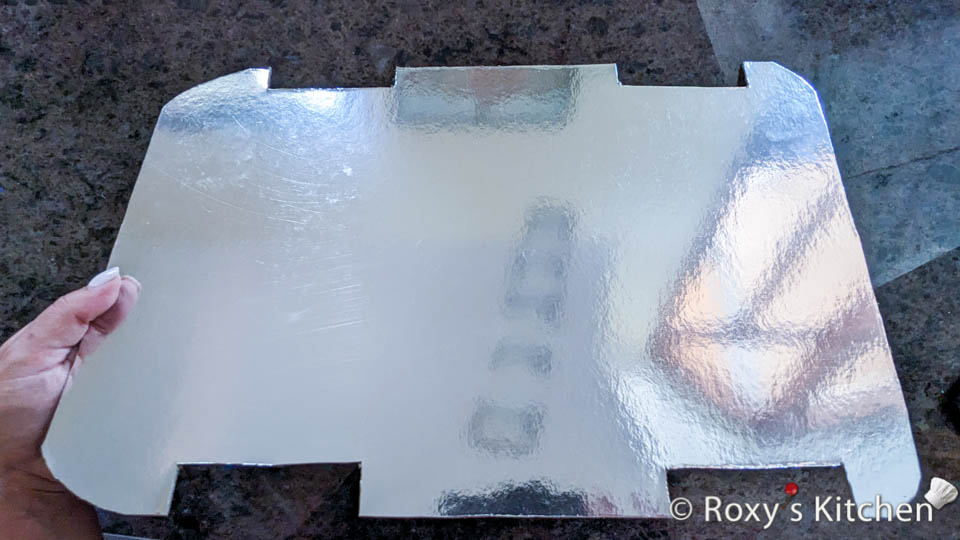
On the back of the cake board, I used a pencil to trace the shape of the car, which was 28 cm wide and 43 cm long (11’’ x 17’’). The wheels were 9 cm (3.5’’) wide, so the cutout was slightly bigger than that (9.5 cm / 3.75’’).
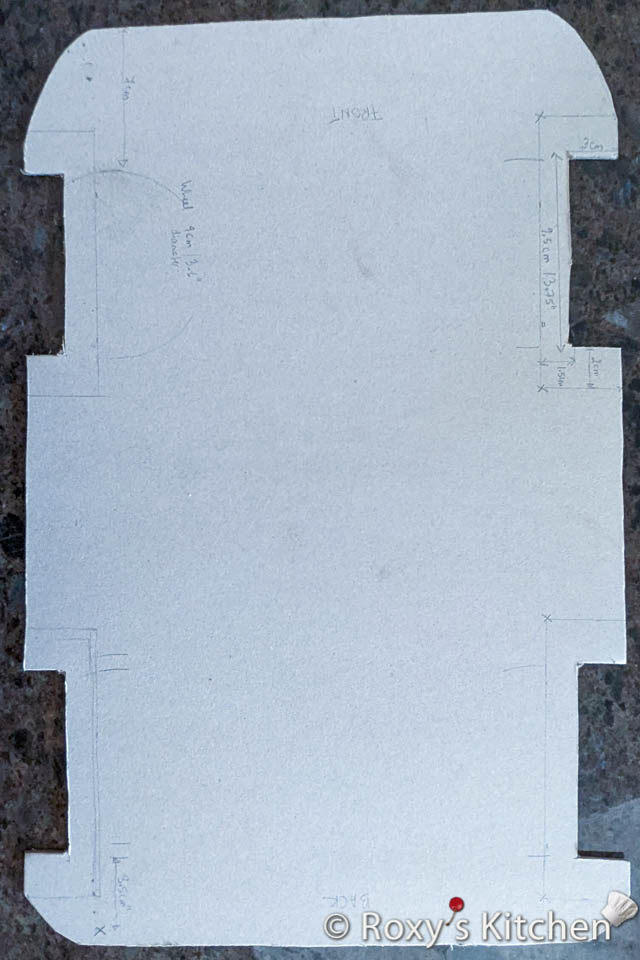
Then, I used the first cake board template to create another template from the second cake board, as well as one from parchment paper. The second cardboard cake board template is used as the ‘floating’ cake board on which we’ll place the decorated cake at the end. Why floating? Because I attached these styrofoam ball halves to the board using a glue gun, creating a small distance between the base of the car and the surface under the cake. This way, my tires and car look more realistic. The easiest way to cut the styrofoam balls without creating too much mess is by heating a knife or cutter blade. The hot blade melts through the styrofoam, giving you smooth, precise cuts.
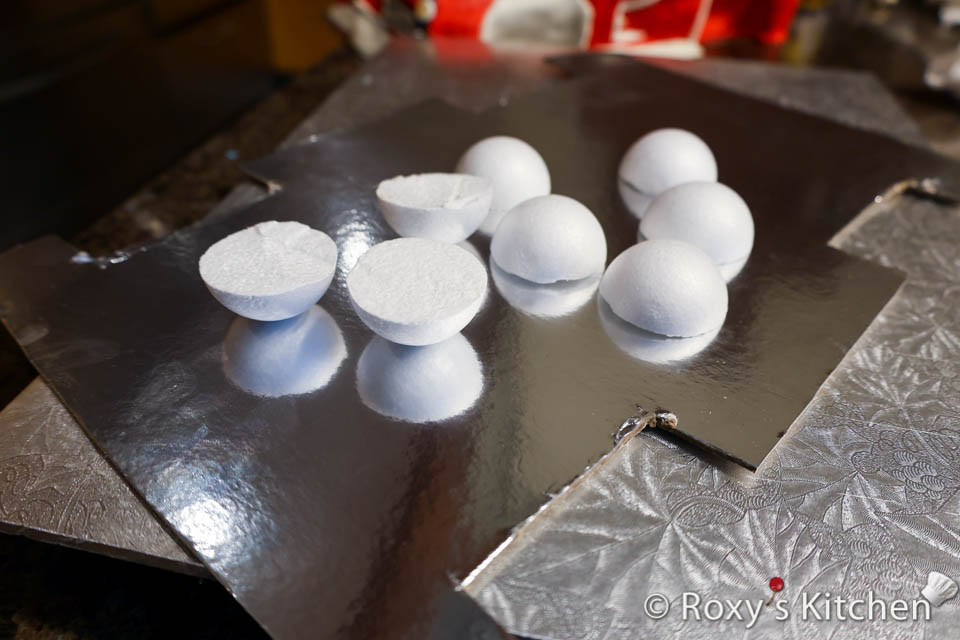

I also made templates out of parchment paper for the car’s windshield and side windows. The windshield had an 18 cm (7’’) bottom base, a 12 cm (4.7’’) top base, and sides of 9 cm (3.5’’). The side windows had a 14 cm (5.5’’) bottom base, a 9 cm (3.5’’) top base, one side of 3 cm (1.2’’), and the other side of 7 cm (2.8’’).
So, it’s important to plan ahead and create your templates before you start stacking, carving, and decorating your cake.
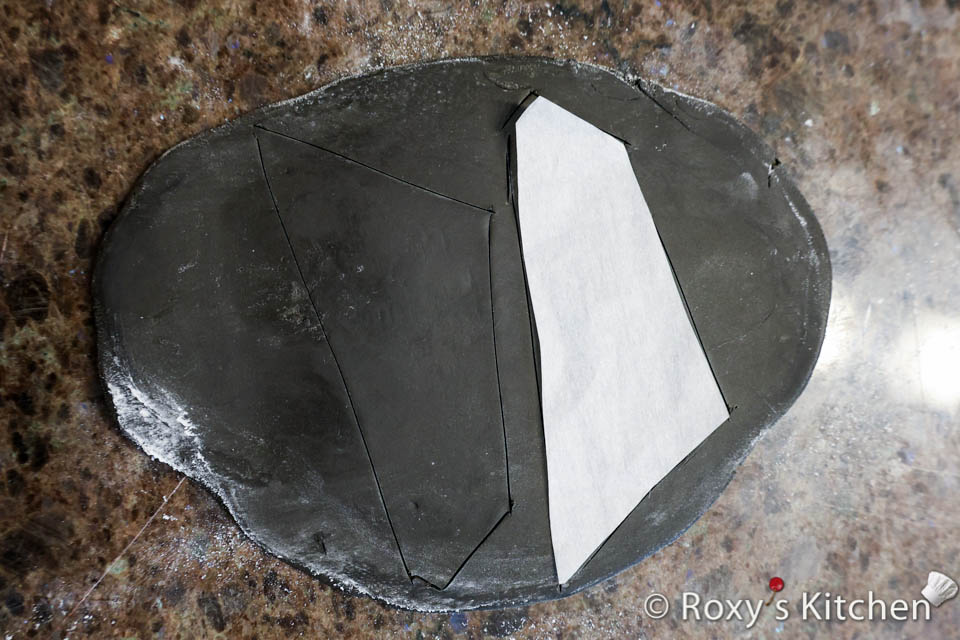
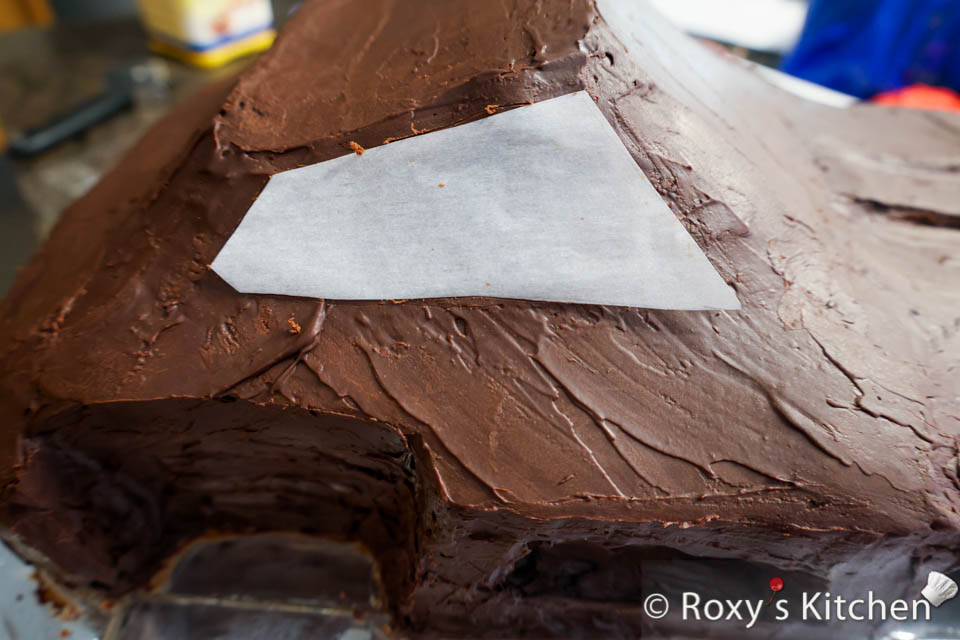
Lastly, I always have printed pictures of what I want to make—whether it’s a design generated with AI apps or downloaded from the internet. Make sure to have printed pictures of your design handy!
Filling and Frosting the Cake
Bake your cakes and make the raspberry cream cheese buttercream filling using the ingredients and recipes provided above.
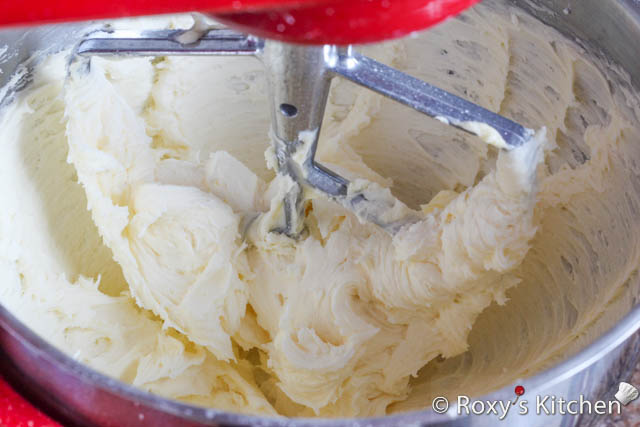
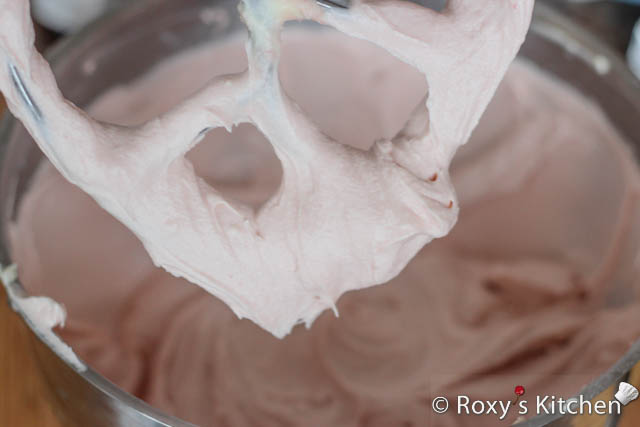
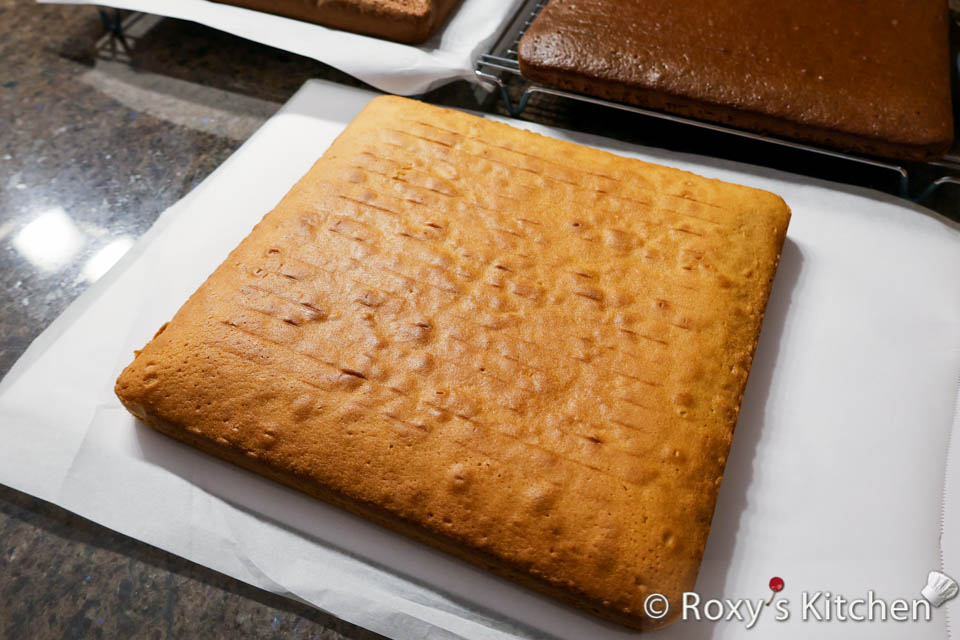
Now, let’s fill and frost our cake. My car cake had 3 main layers of vanilla cake and 2 layers of raspberry cream cheese buttercream filling, along with fresh raspberries. I also used a vanilla & strawberry-flavored simple sugar syrup to keep the cake extra moist.
First, use the template to cut the shape of the car out of the first large sheet cake. My big cake pan was 38 cm x 38 cm (15’’ x 15’’). Then, cut the cake horizontally in two and transfer the top layer to a separate cake board.
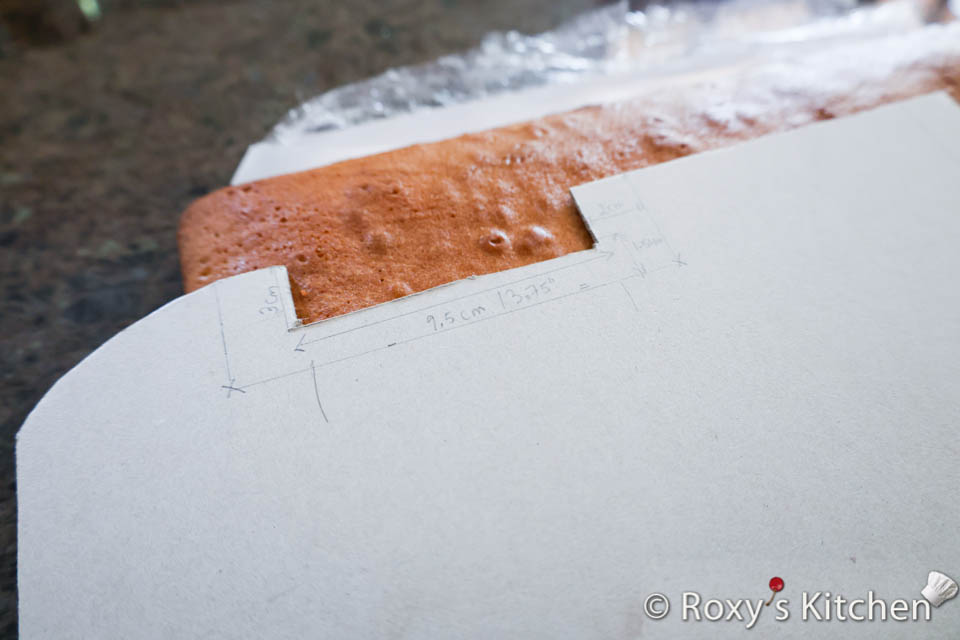
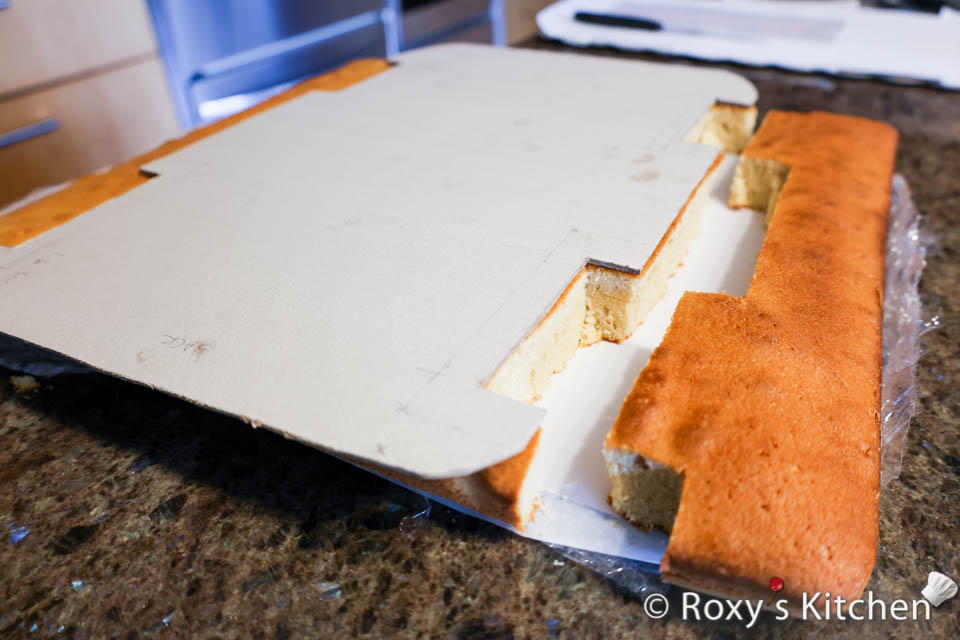
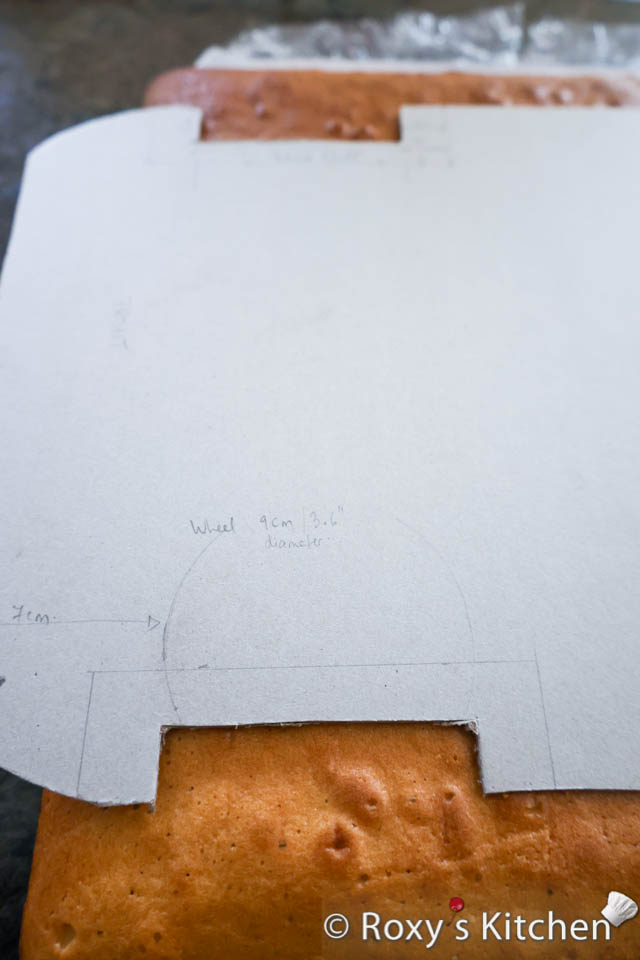
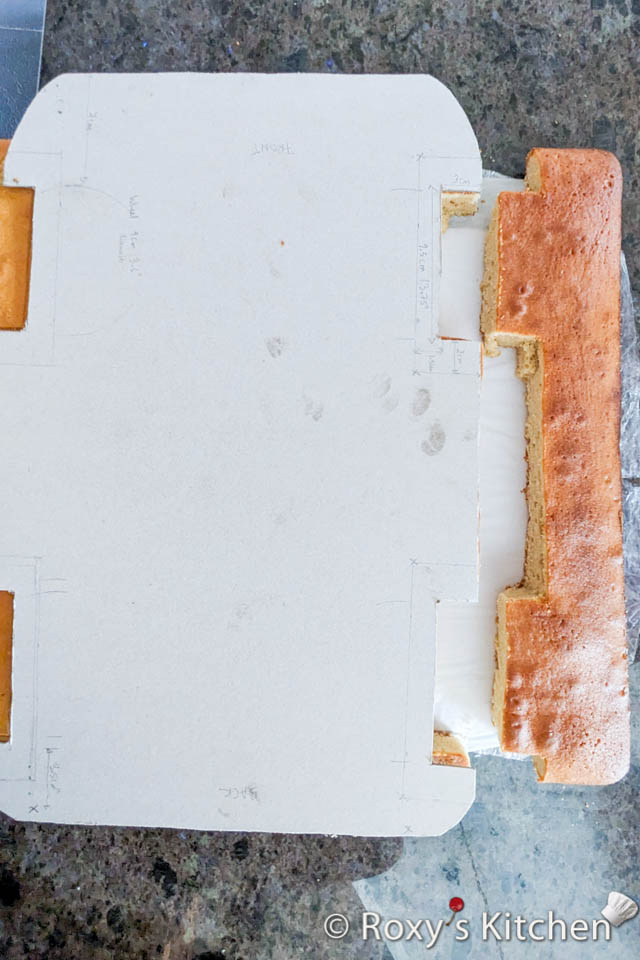
If using sugar syrup, moisten your first cake layer. Spread cream cheese buttercream on top and add fresh raspberries that were previously washed and dried. Place the second cake layer on top and moisten it with sugar syrup. Since my sheet cake was not as long as my car, I had to use the leftover cake to build the front of the car. If you have a rectangular cake pan that’s as wide and long as your car, then you don’t need this extra step.

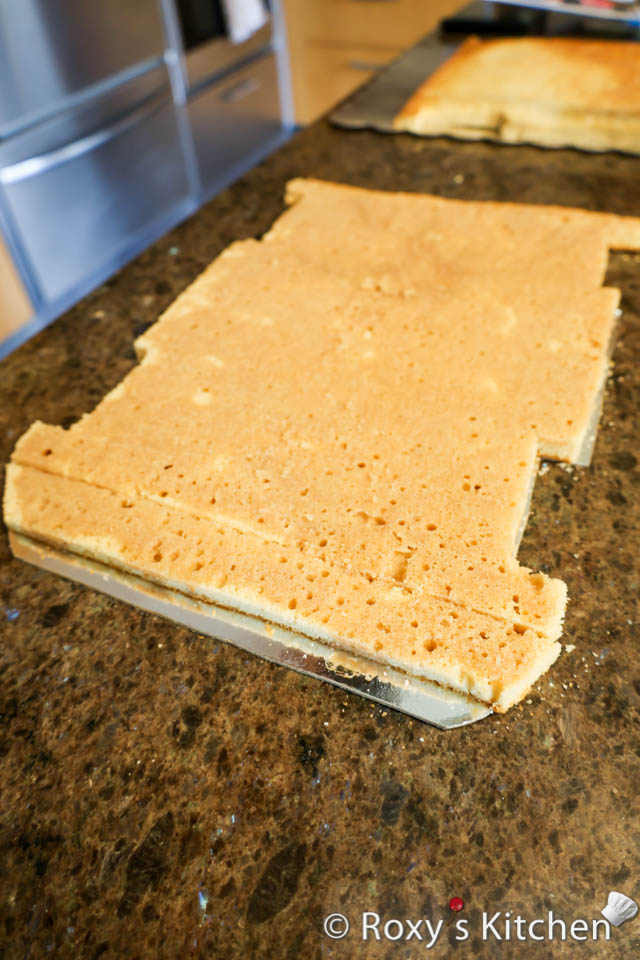
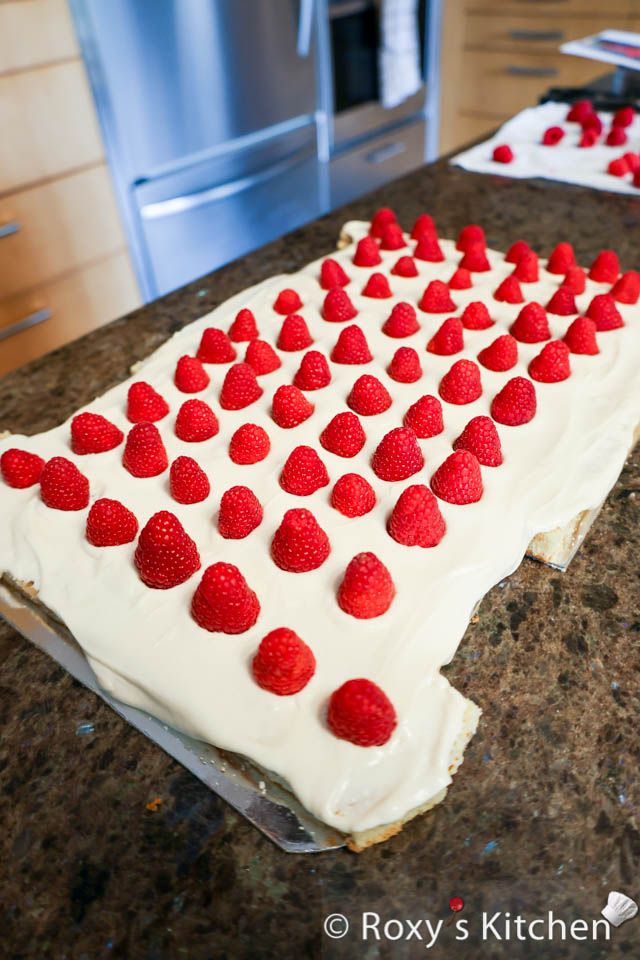
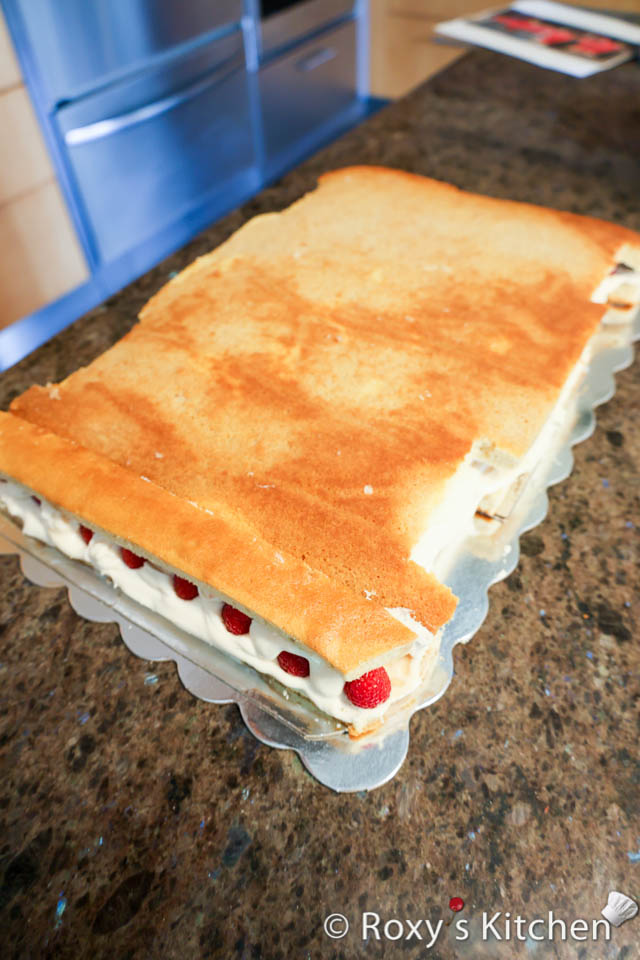
Next, cut the second vanilla sheet cake using the template, but only two-thirds of the car (the back part). This is because, as you build your cake up, the front of the car will be slimmer than the back, so you’ll need more cake at the back and less at the front. Cut the sheet cake horizontally in two.
Spread cream cheese buttercream on top of the second cake layer and place fresh raspberries on two-thirds of the cake only (i.e., the middle and back of the car). Place the third cake layer on top and repeat the steps.
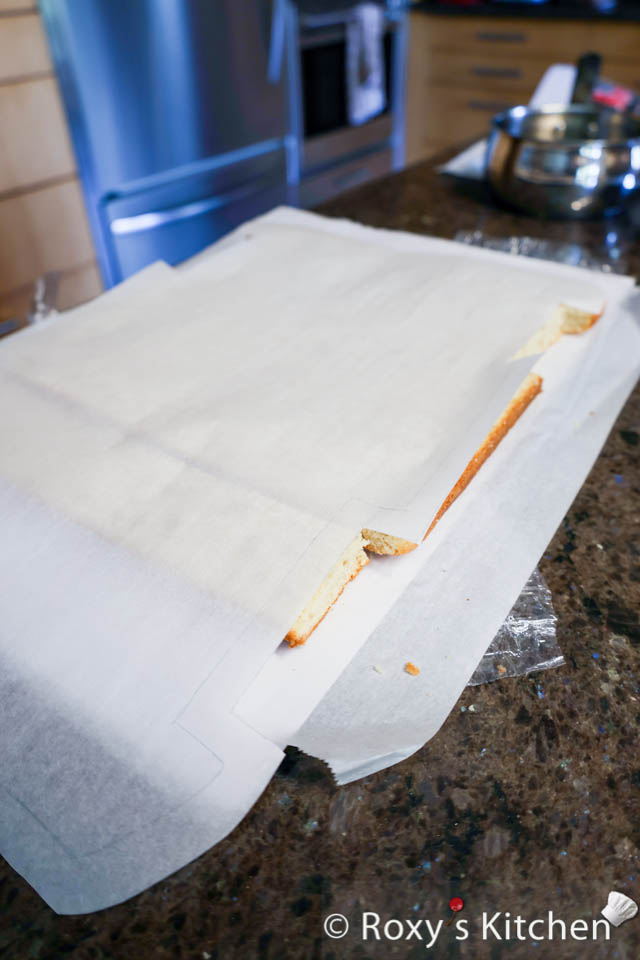
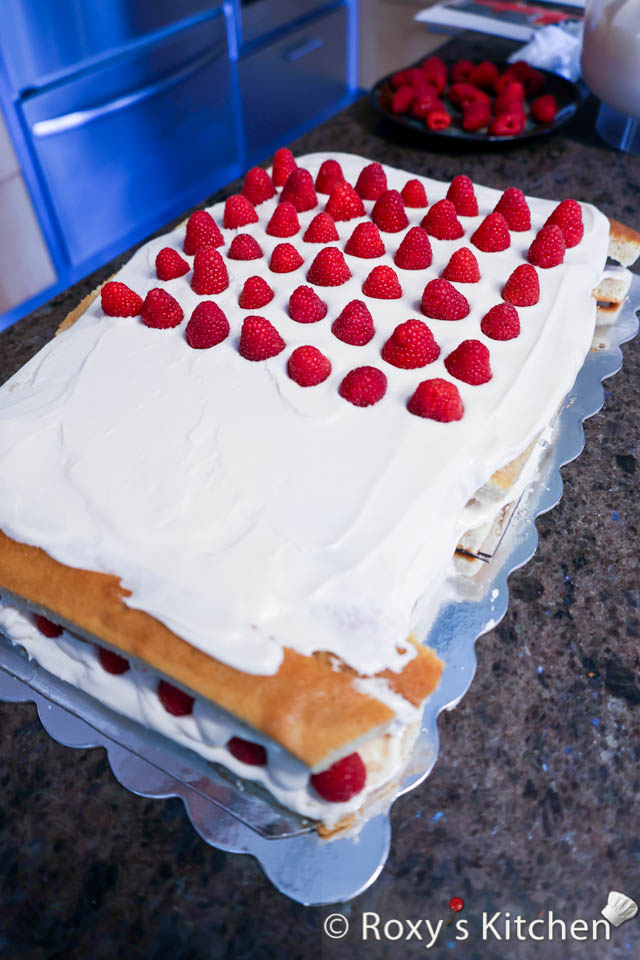
Use leftover cake and cream cheese buttercream to build the middle and back of the car as seen below.
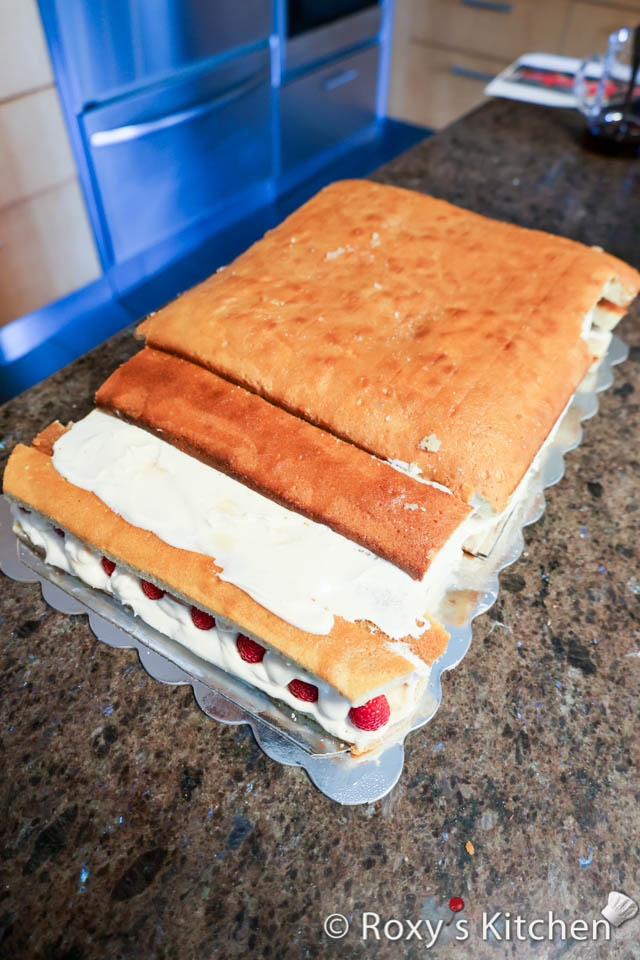
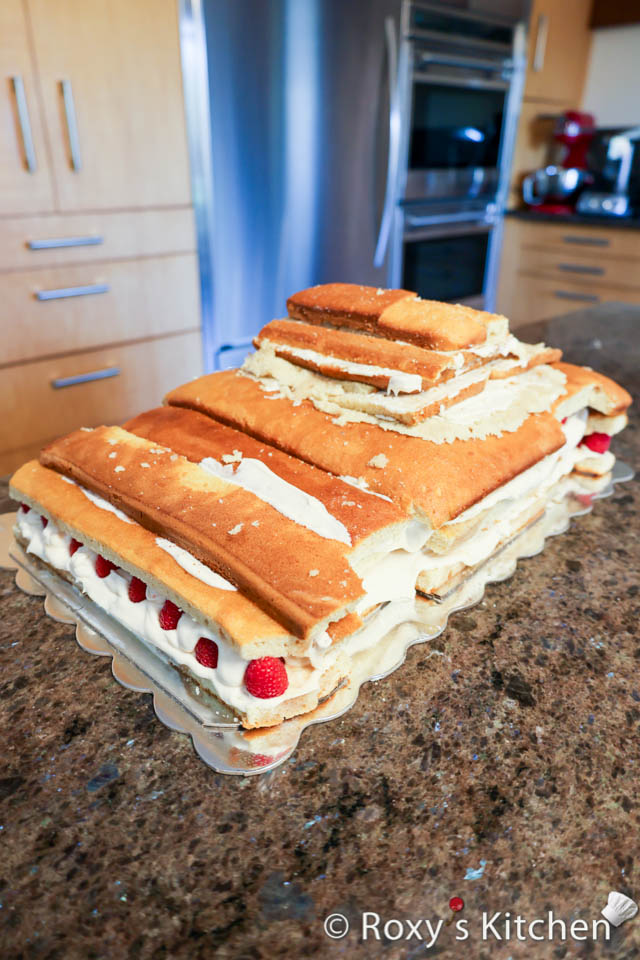
Once the cake is filled, cover it with plastic wrap and place it in the freezer for 2 hours. Freezing the cake makes it much easier to carve without it breaking apart.
Carving & Ganaching the Race Car Cake
Make your chocolate ganache. Cover it with plastic wrap (touching the surface of the ganache to prevent condensation from forming). Allow it to cool at room temperature until it reaches a thick pouring consistency.
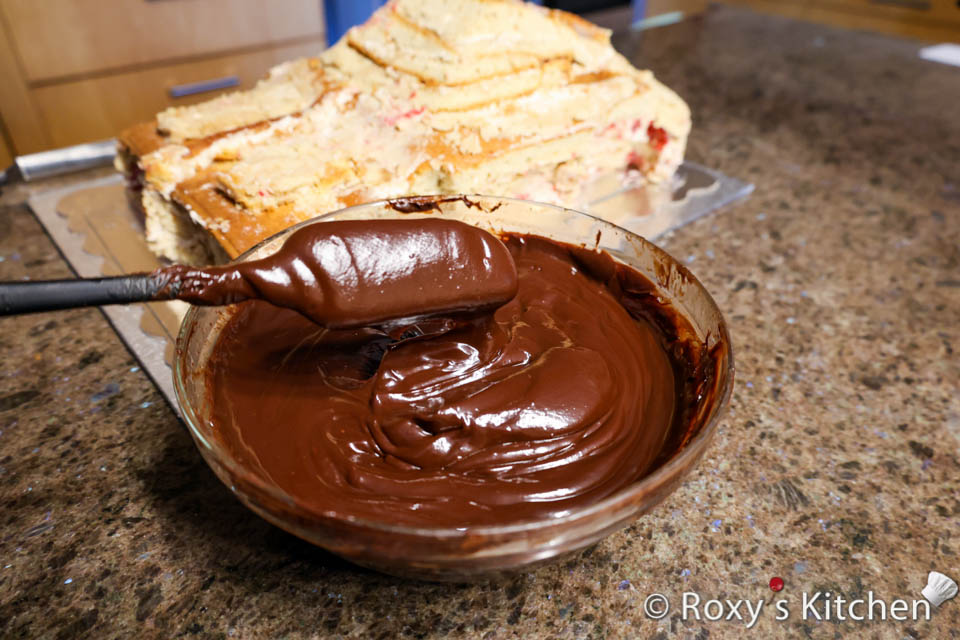
Using a serrated knife, carve the cake into the shape of a car. I did not use any templates for carving (other than the base cake board template), so you can watch the video to see how I carved and shaped the car cake to bring it to life. The only tip I can give you is to always have your car picture printed and handy to refer to while carving out the details. Don’t be afraid to cut into the cake to make more pronounced shapes. The angles and shapes will look less drastic once you cover the cake in modeling chocolate.
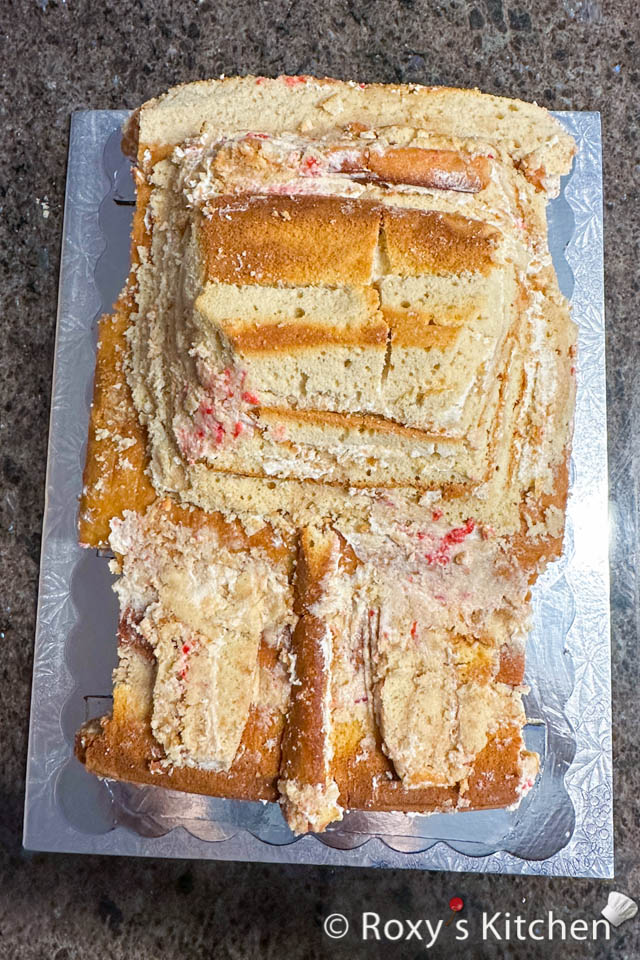

Note that your car-shaped cake board needs to be visible as you carve the cake. You need to leave enough space so that you can cover the cake with ganache, with the modeling chocolate and add the car design details made out of the modeling chocolate. Everything needs to sit on the cake board so you should leave at least 2.5 cm (1 inch) of cake board around the carved cake.
Use the cake scraps to fill any visible gaps and build up the car parts, such as the car hood. Then, place the cake in the fridge for 1 hour.
Crumb-coat the cake with a thin layer of chocolate ganache using a small offset spatula.
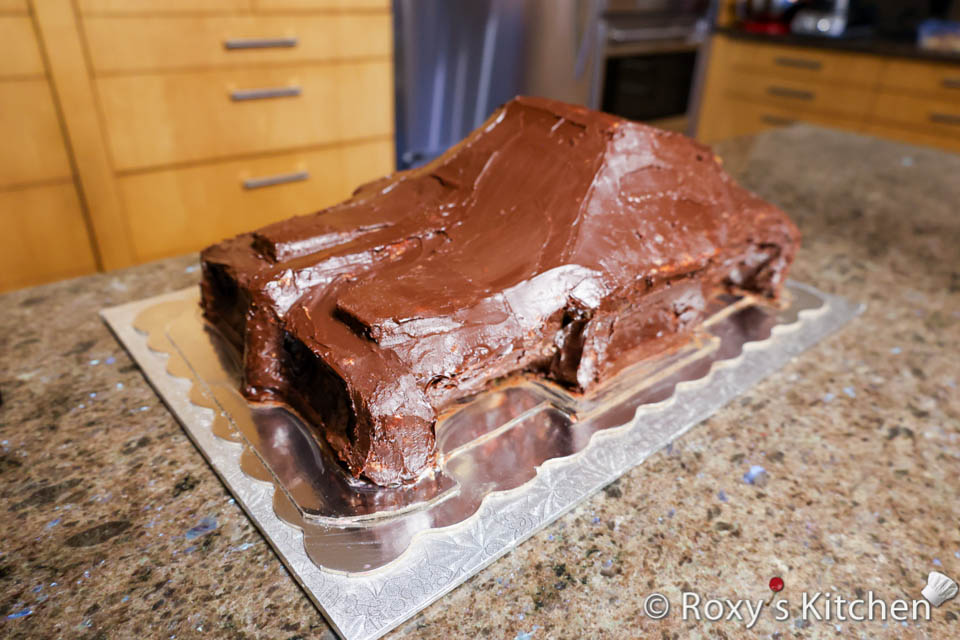
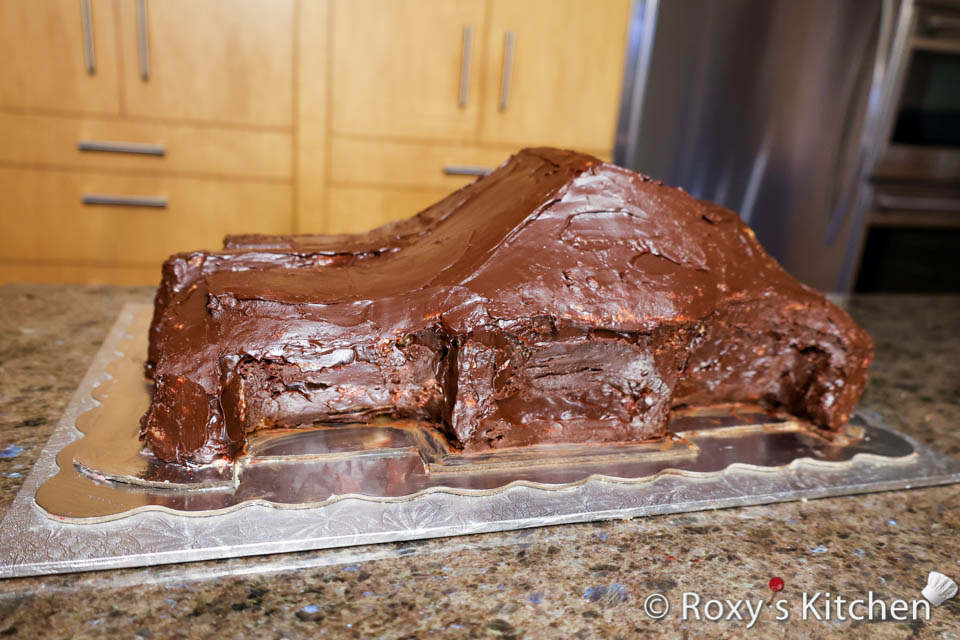
Refrigerate the cake for one hour, then apply another layer of chocolate ganache, smoothing it out with your spatula. Keep the cake in the fridge until the chocolate hardens.
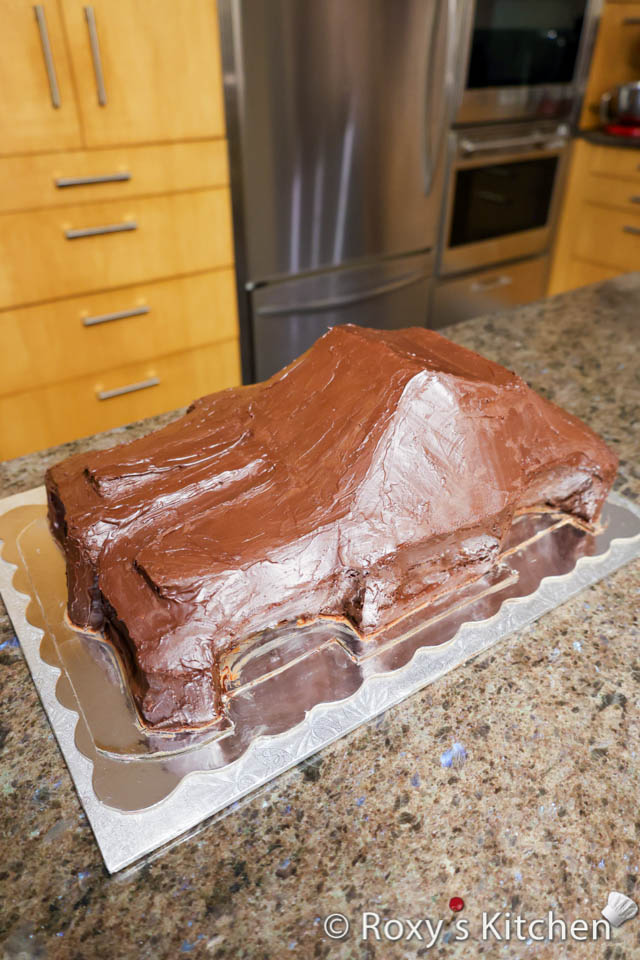

Covering the Cake with Modeling Chocolate
Now, onto the fun part—making this cake look like a race car! I covered the cake in modeling chocolate, but you can use fondant too. This was my first time working with modeling chocolate, and it won’t be my last! It’s easier to cover the cake in sections, hide the seams, and it doesn’t dry out as quickly as fondant. Plus, it’s much more delicious!
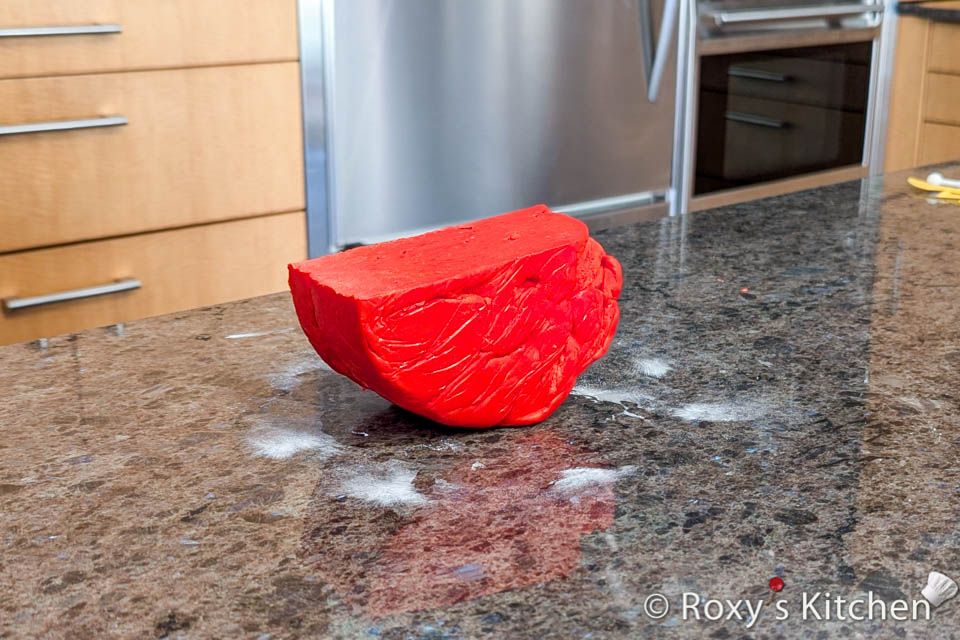
Knead your modeling chocolate until it’s nice and pliable. Dust your work surface with cornstarch and roll out the red modeling chocolate to cover the back of the car. Use a ruler to measure the part of the car that you want to cover, then cut the rolled modeling chocolate accordingly.
Place the rolled modeling chocolate on the cake and use a fondant smoother (or the palm of your hand) to smooth it out.

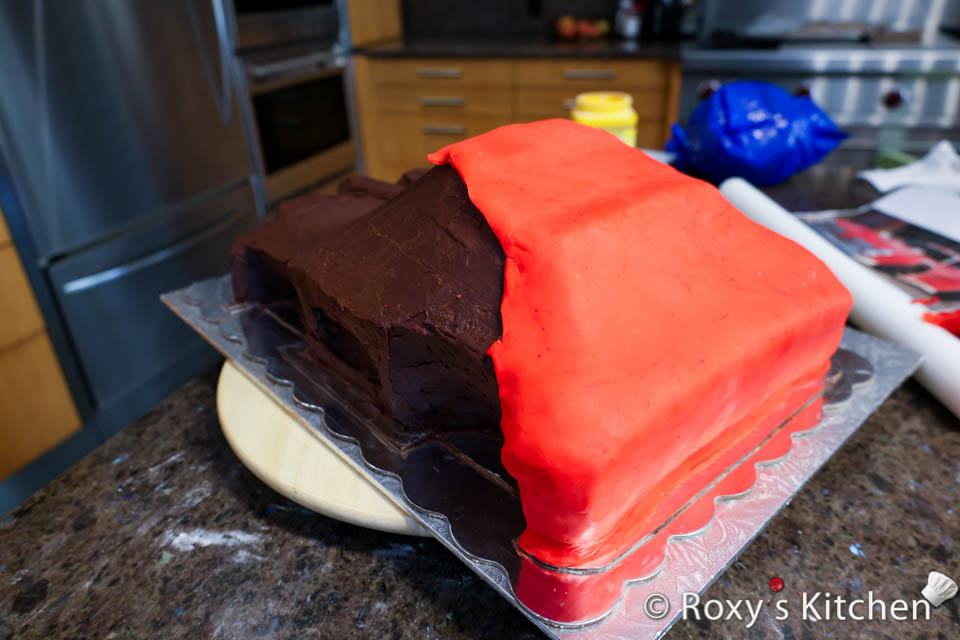
Next, use your parchment paper template to trace and cut the windshield and side windows from rolled black modeling chocolate. Place them on the cake.
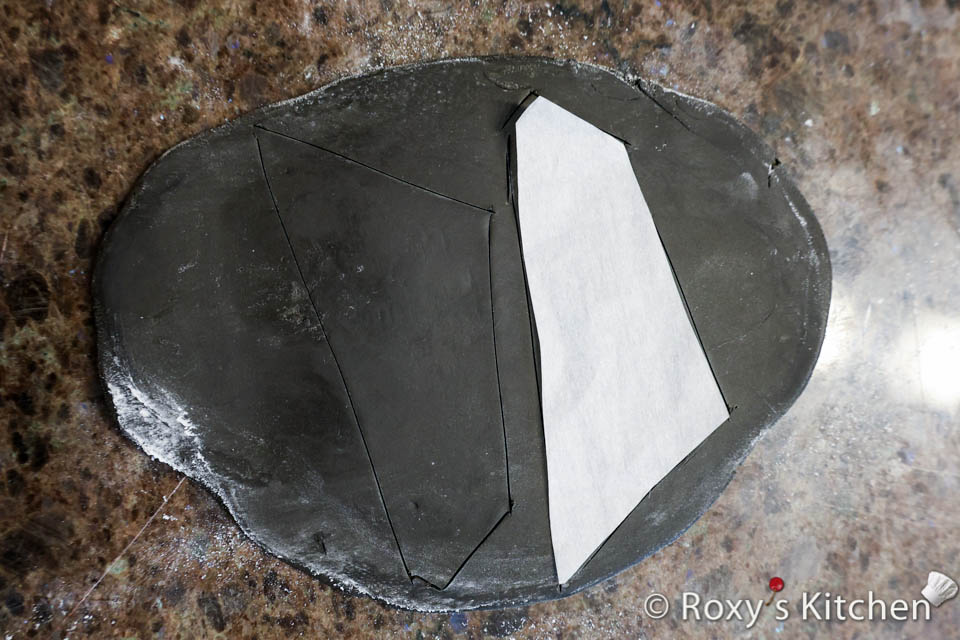
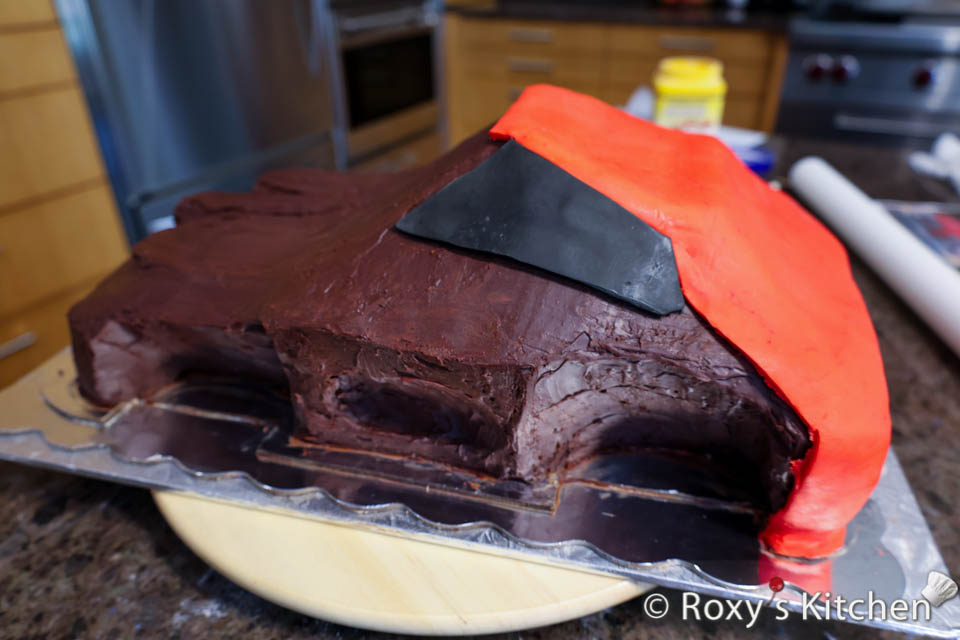
Use the fondant smoother and your fingers to smooth out the seams. The warmth of your hand will slightly melt the chocolate and make the seams hardly visible.
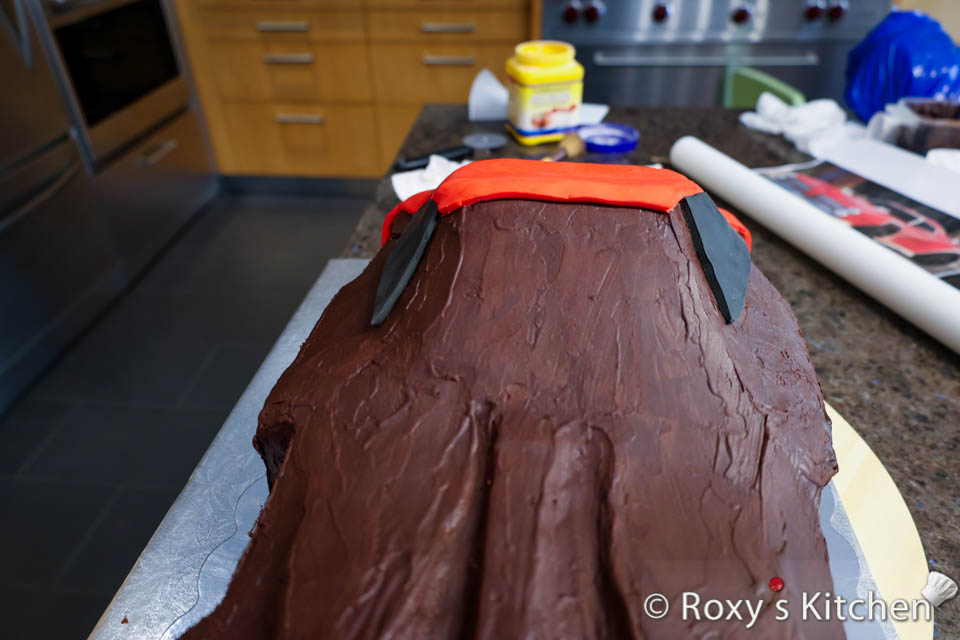
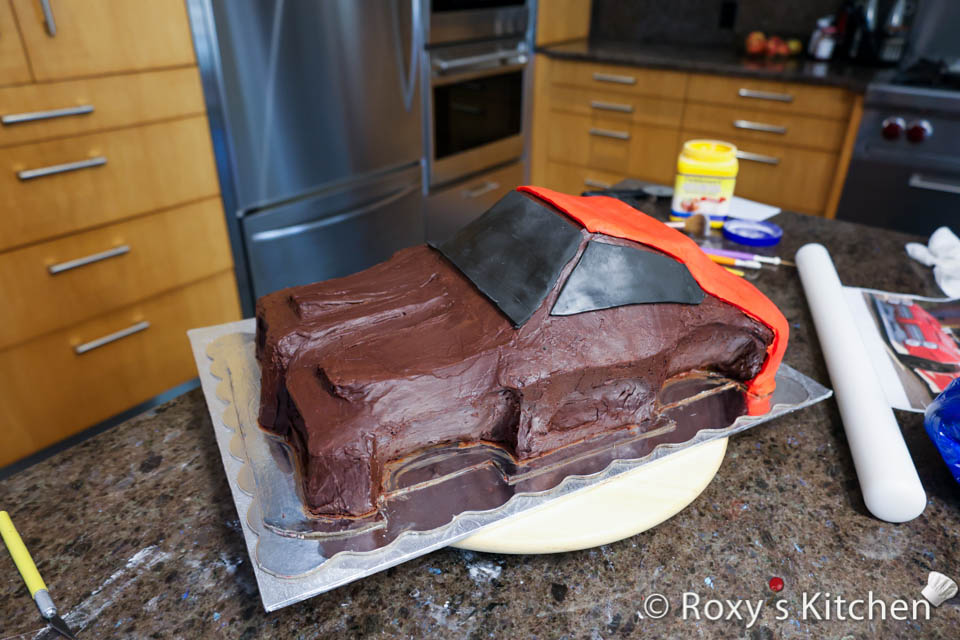
If you have any excess modeling chocolate, trim the edges using an X-Acto knife or any sharp knife.
Roll out and cut thin strips of white modeling chocolate to cover the seams.
Continue rolling and cutting the modeling chocolate, covering your race car cake in sections and replicating as many of the design elements as you want based on your car picture.
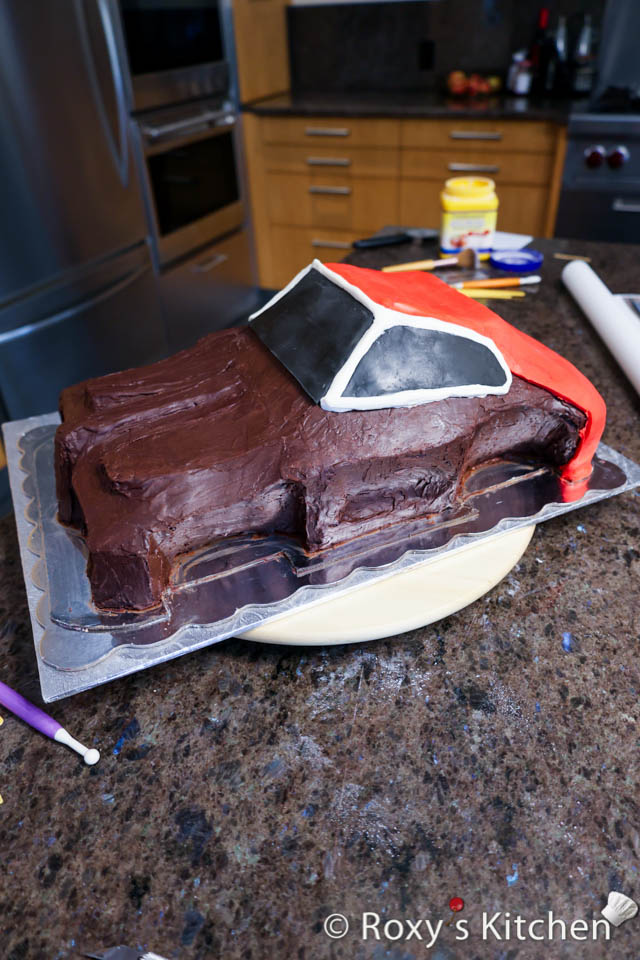
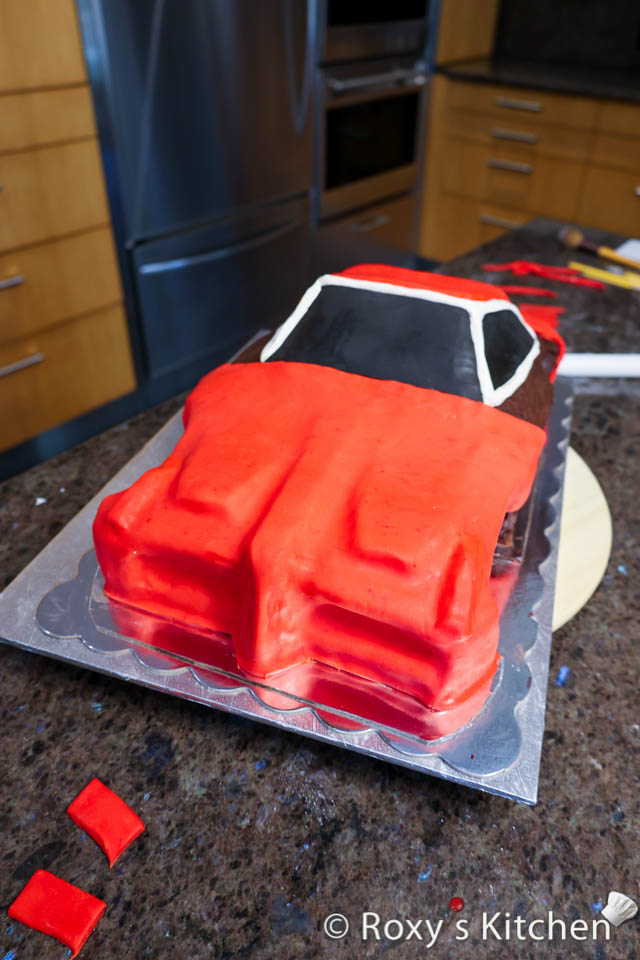
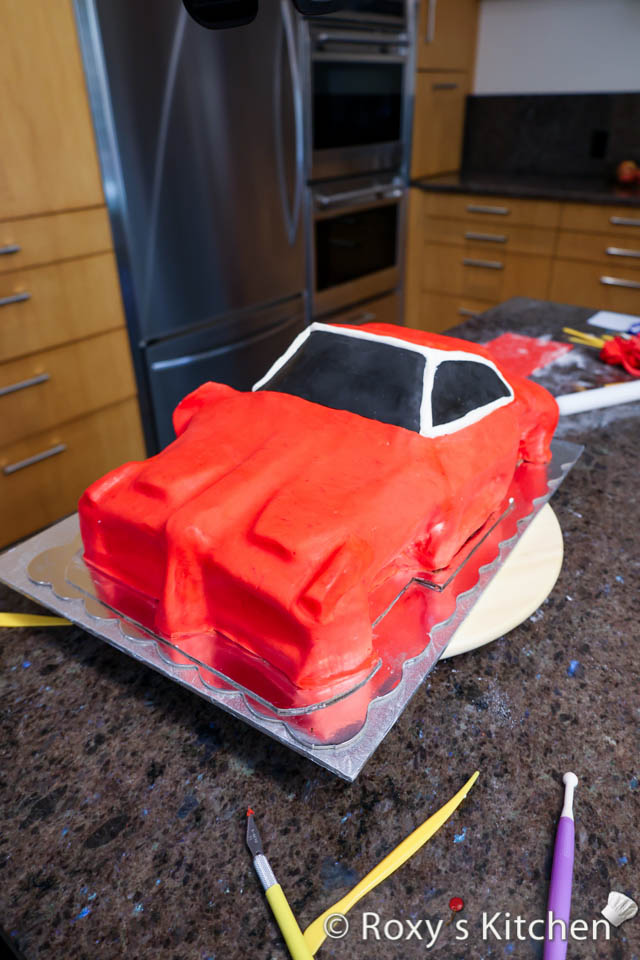

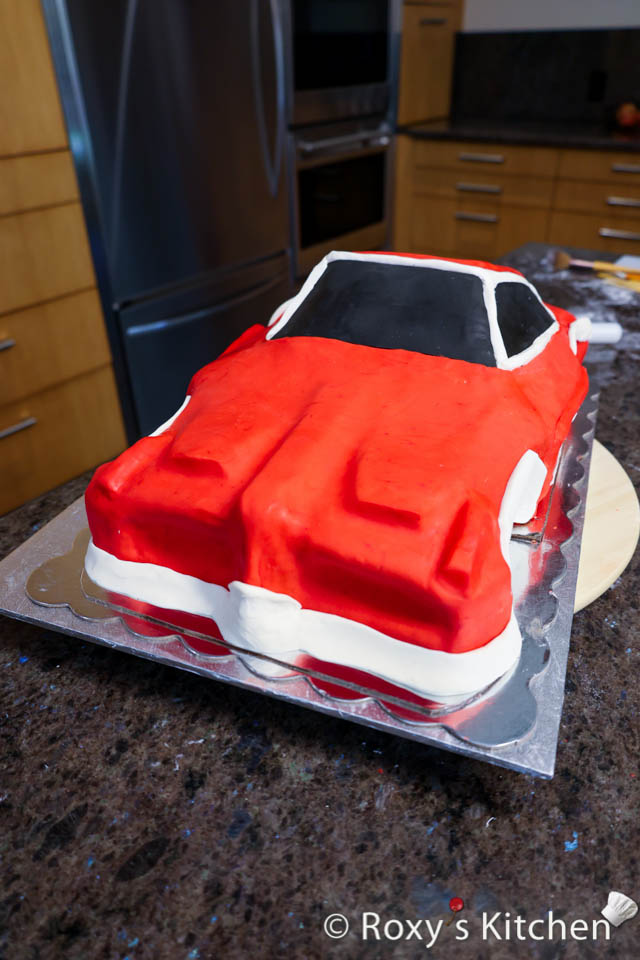
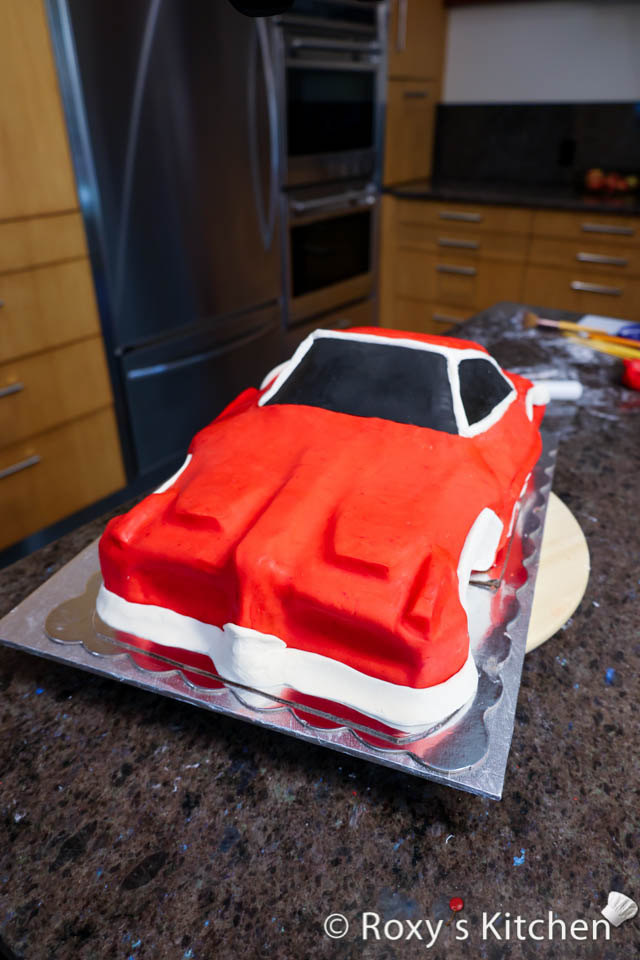
Adding the Final Details
I made the headlights out of white modeling chocolate and some melted gelatin mixed with a bit of water, which was placed in tiny sphere silicone molds. It was difficult to get the gelatin to stick to the modeling chocolate even when using edible glue, so I’m not sure if it was worth the trouble. I like the look, but I’ll need to find another solution for next time. I considered using melted isomalt but I did not use this out of fear that it would melt once I placed the cake in the fridge.
Then, I placed the headlights on black rectangles on which I painted the stripes and edges using a brush and white oil-based food colouring.
I made the car tail lights similarly, but using red modeling chocolate and melted gelatine mixed with red food colouring.
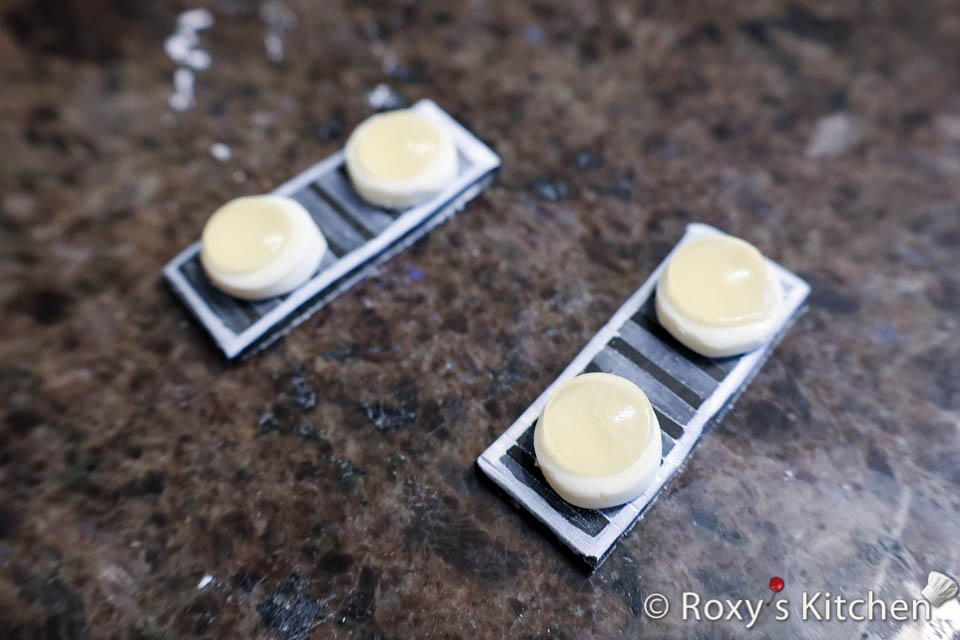
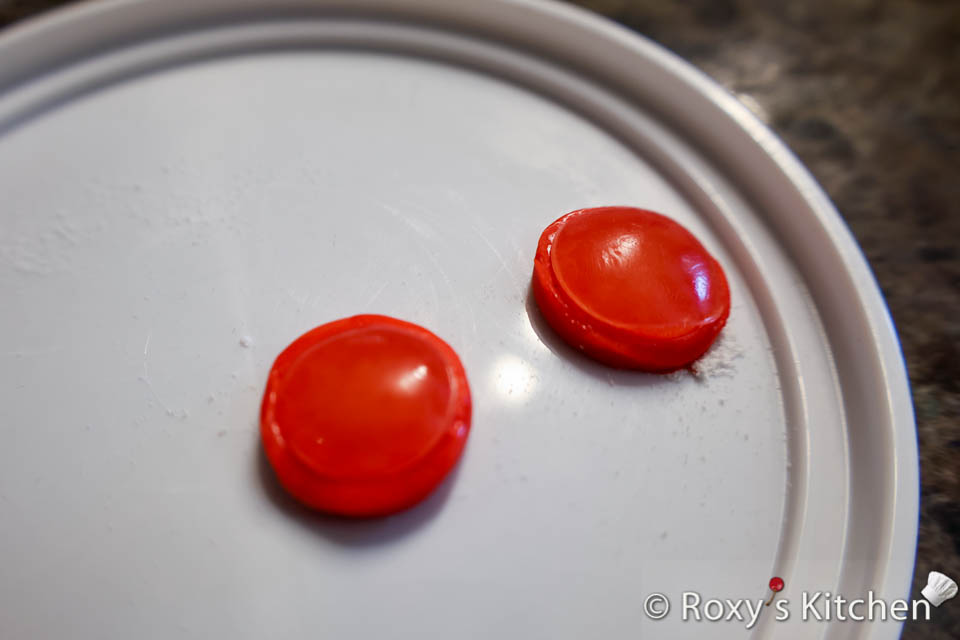
The grill was made out of black and white modeling chocolate.
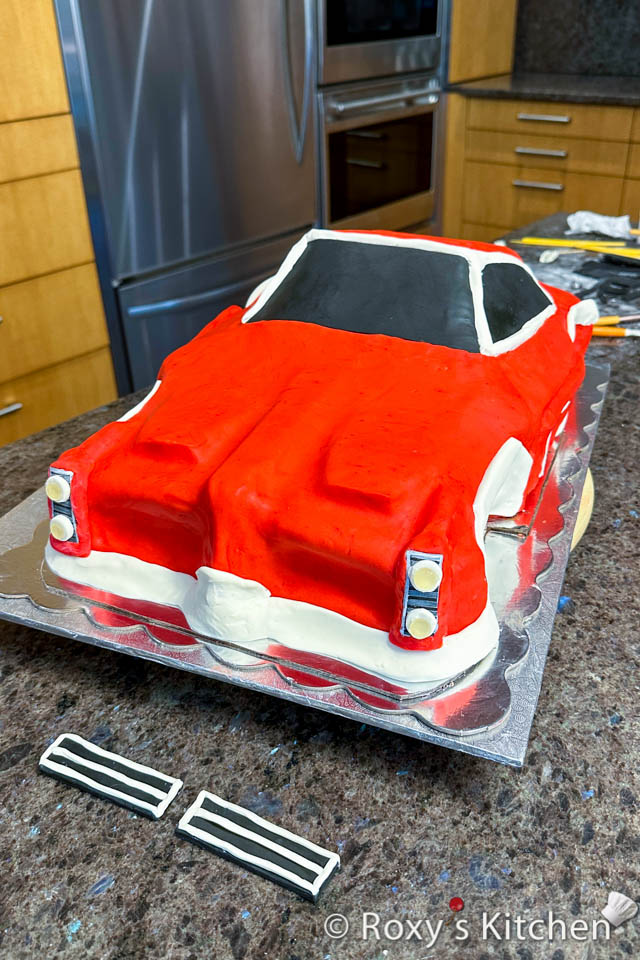
I used the tip of a toothpick and white food colouring to add tiny dots and achieve this look.

Use edible glue to attach all these small parts to the car.
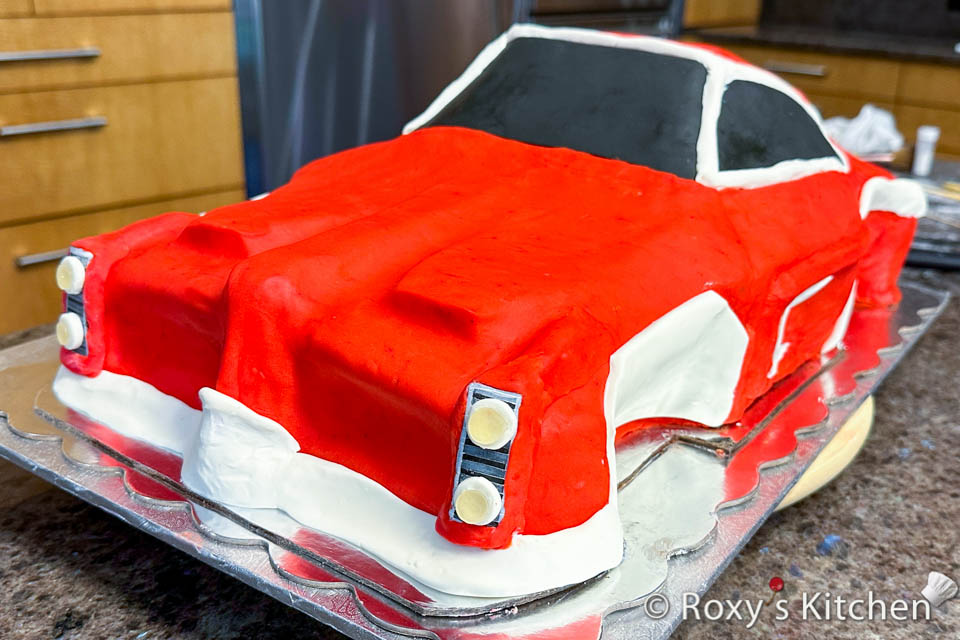
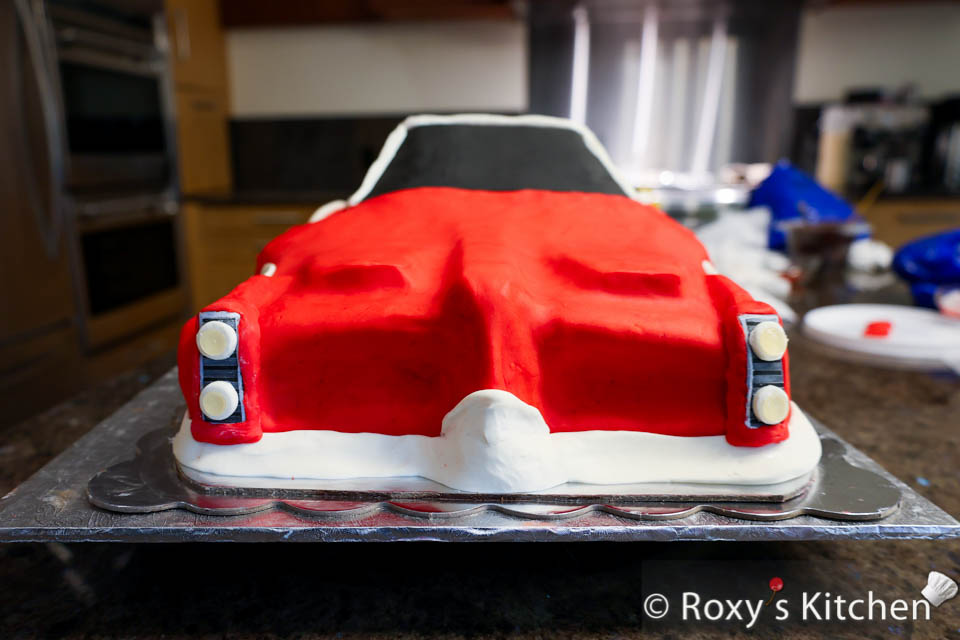
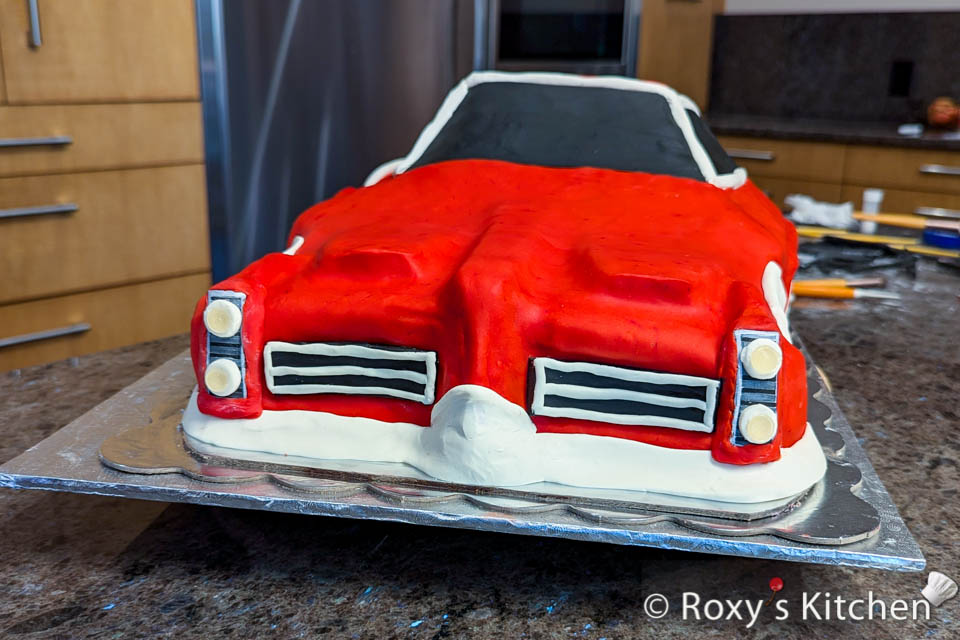
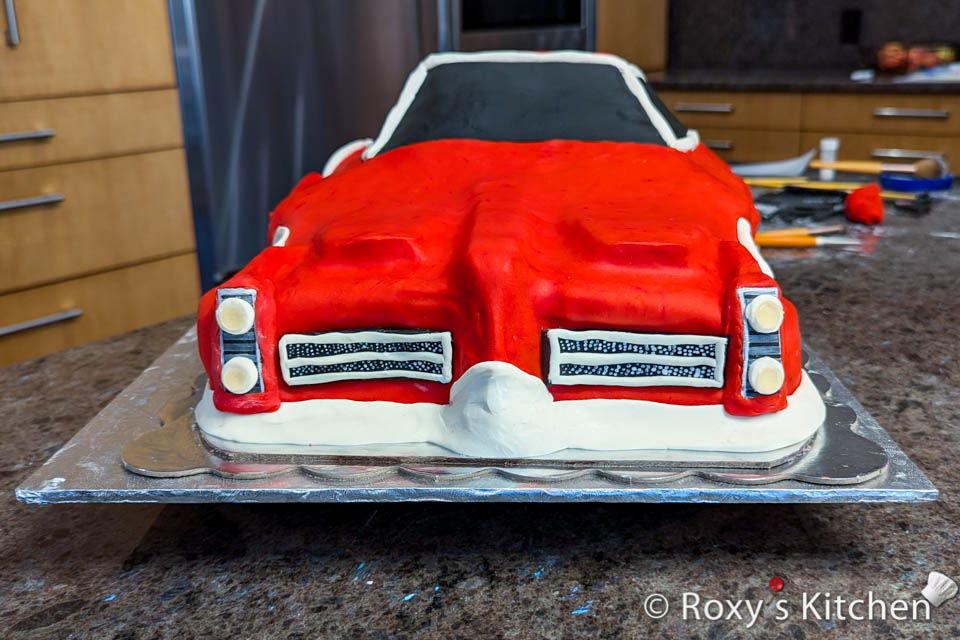
Final Assembly
Place your cake onto the ‘floating’ cake board. Check the first section of this post to see how I made this ‘floating’ board. Then, place the floating board onto the larger cake board.
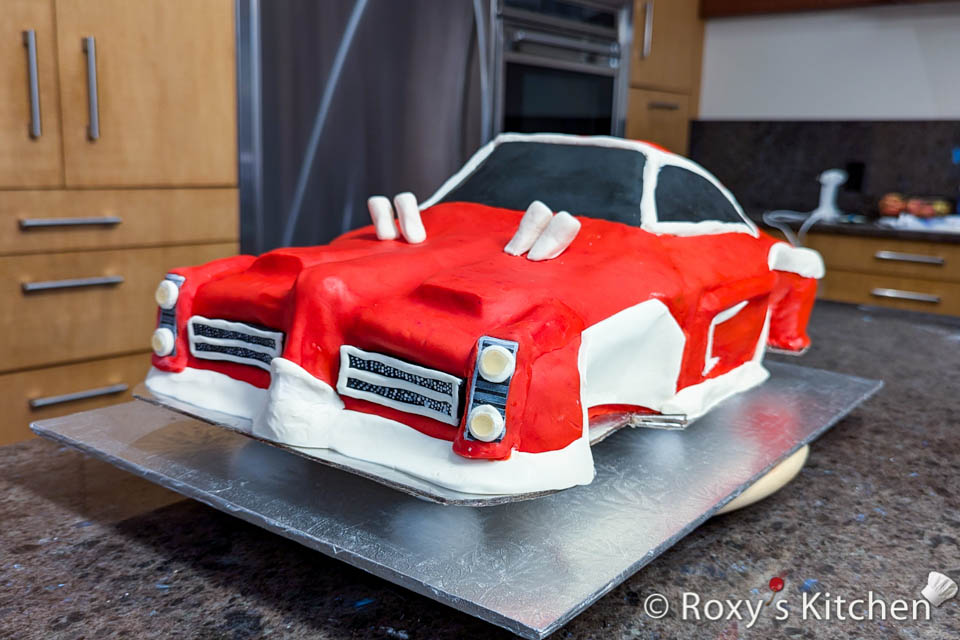
I made the tires and rims using black modeling chocolate. For the rims, press small balls of modeling chocolate into soccer-ball-shaped silicone molds. Place this in the freezer for a few minutes to let the chocolate harden. This way, you can remove them from the mold without ruining the design.
Press modeling chocolate into a 9 cm (3.5’’) wide circle cutter until it’s almost full. Make an indentation/hole in the middle of the tire with your thumb (or the tip of a small fondant rolling pin) that matches the width of your rims. Then, slightly press the hardened soccer-ball-shaped rims into the centre of each tire. Remove the tire from the circle cutter and use your hands to soften the sides and make them slightly round.
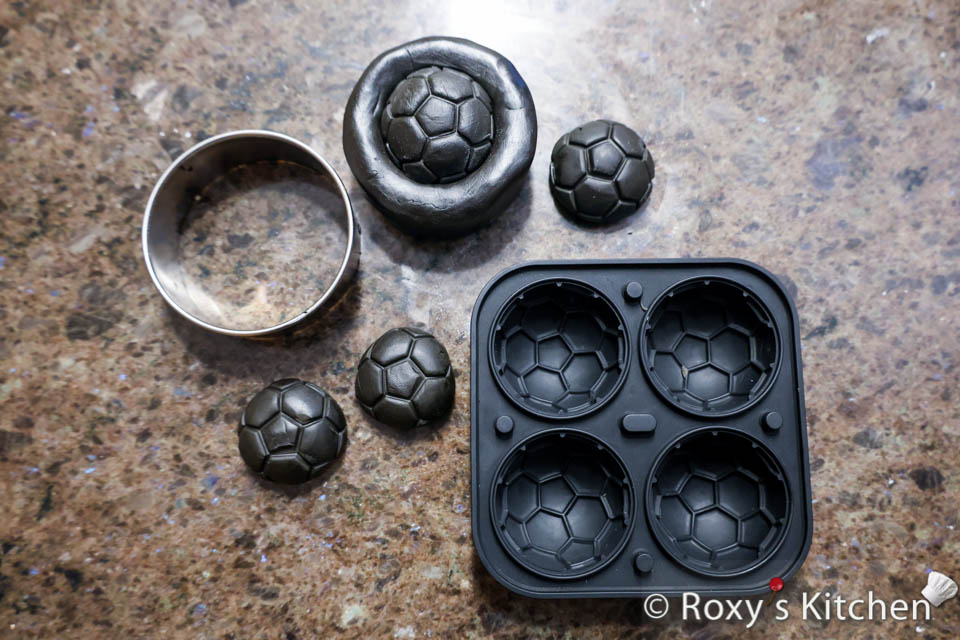
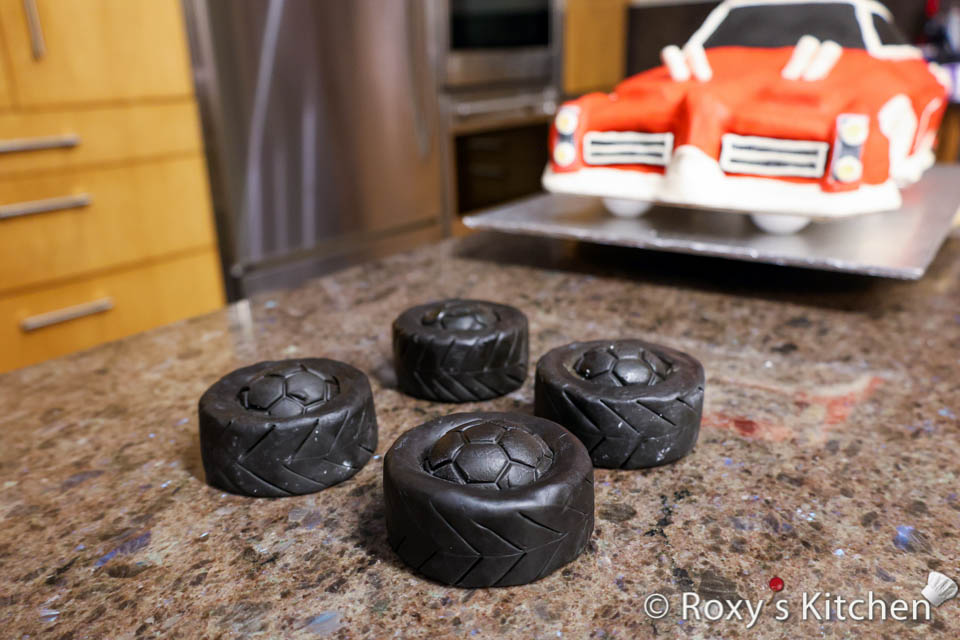
Finally, use a fondant blade tool or the back of a knife blade to create the marks on the tires.
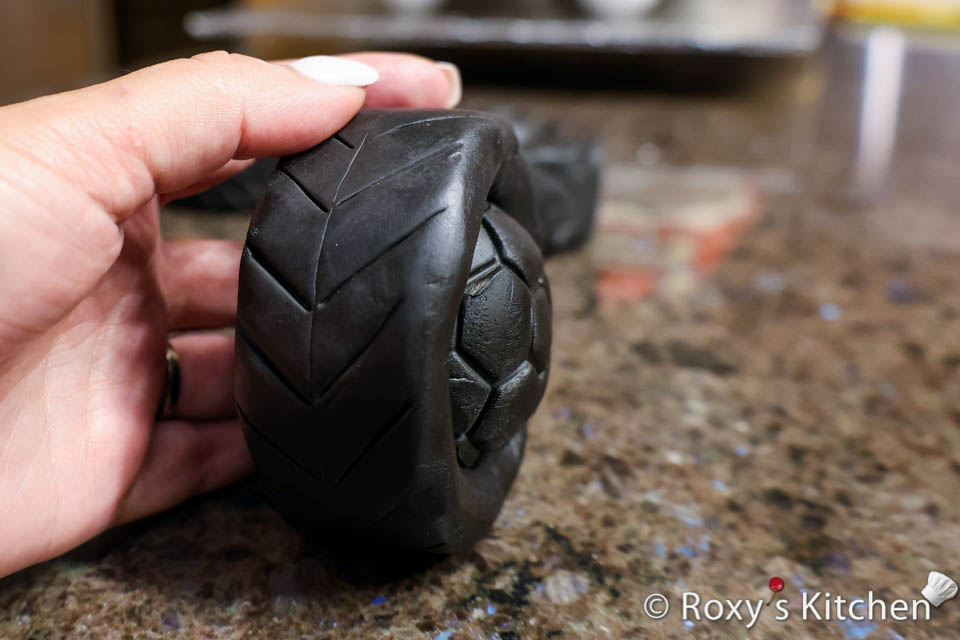
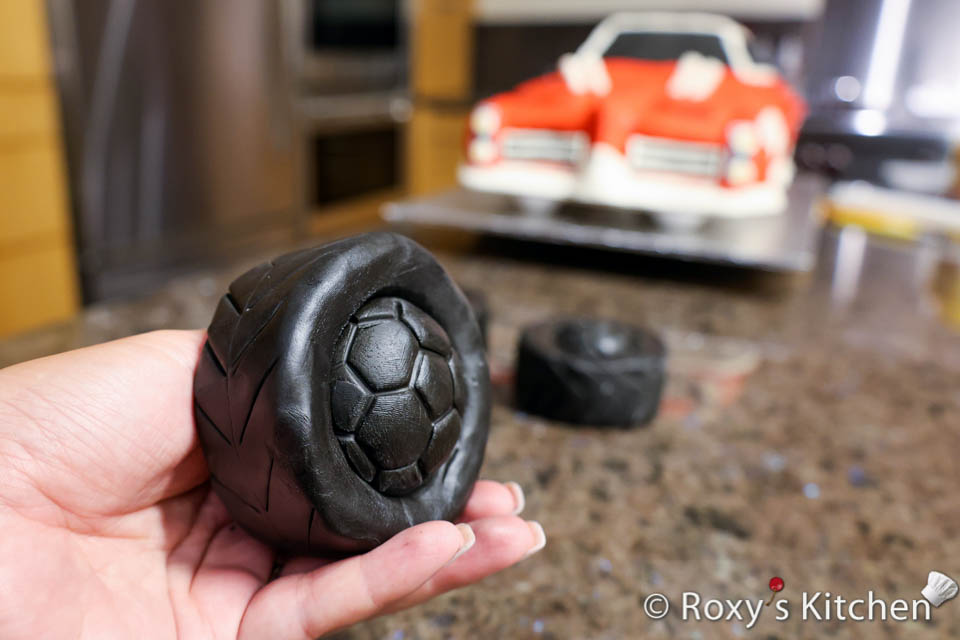
Place them on the cake and use edible glue (if needed) to attach them.
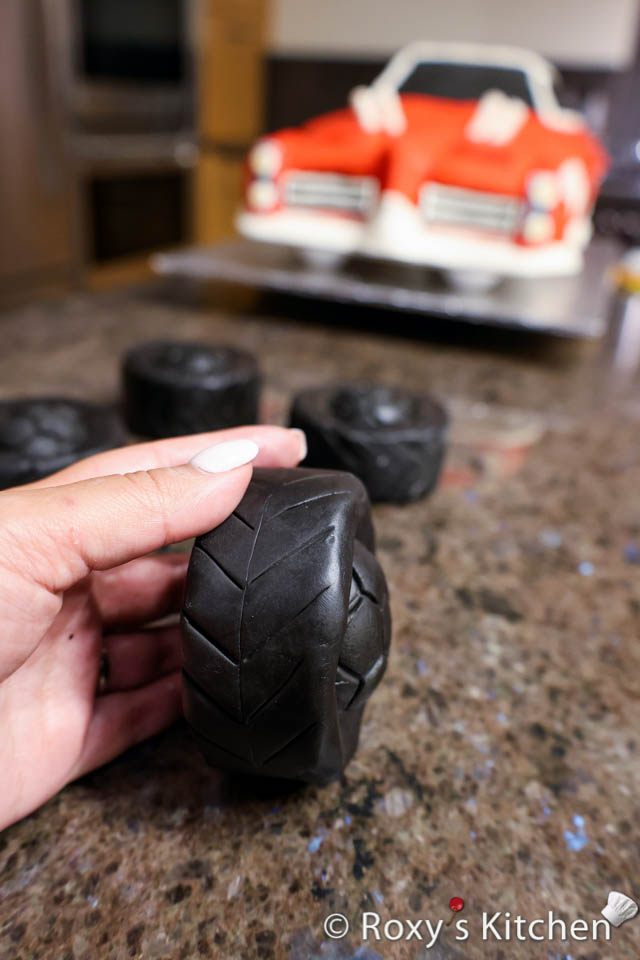
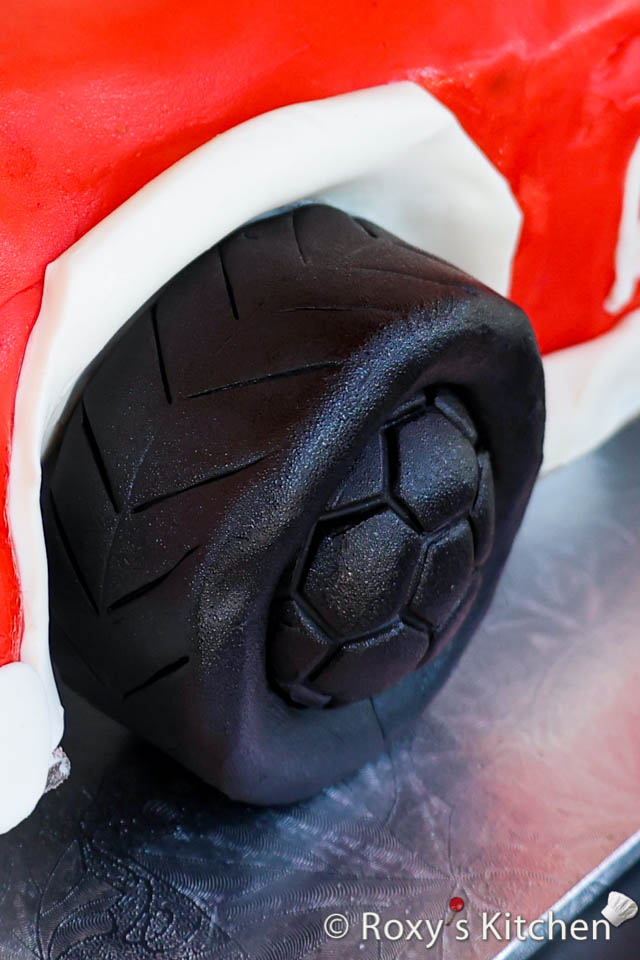
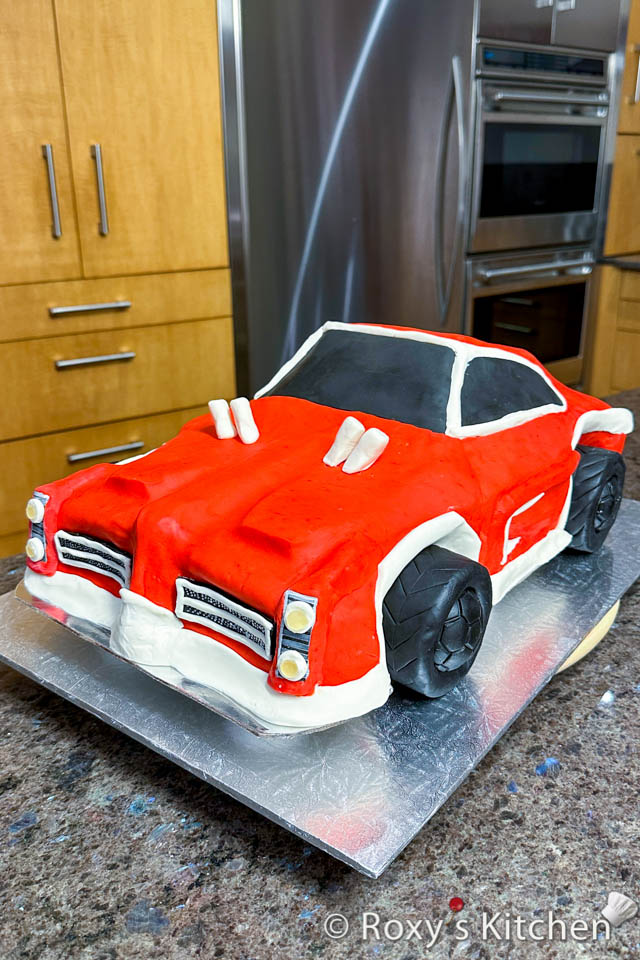
I hope you found this tutorial useful! If you learned how to make a race car cake from my experience and created your own cake, I’d love to hear from you and see your final result.
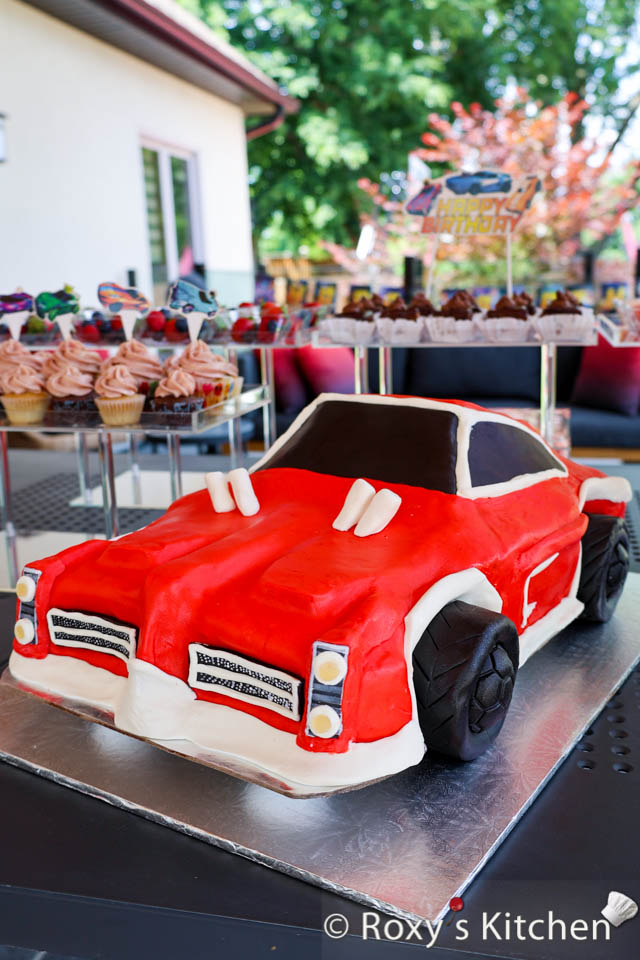
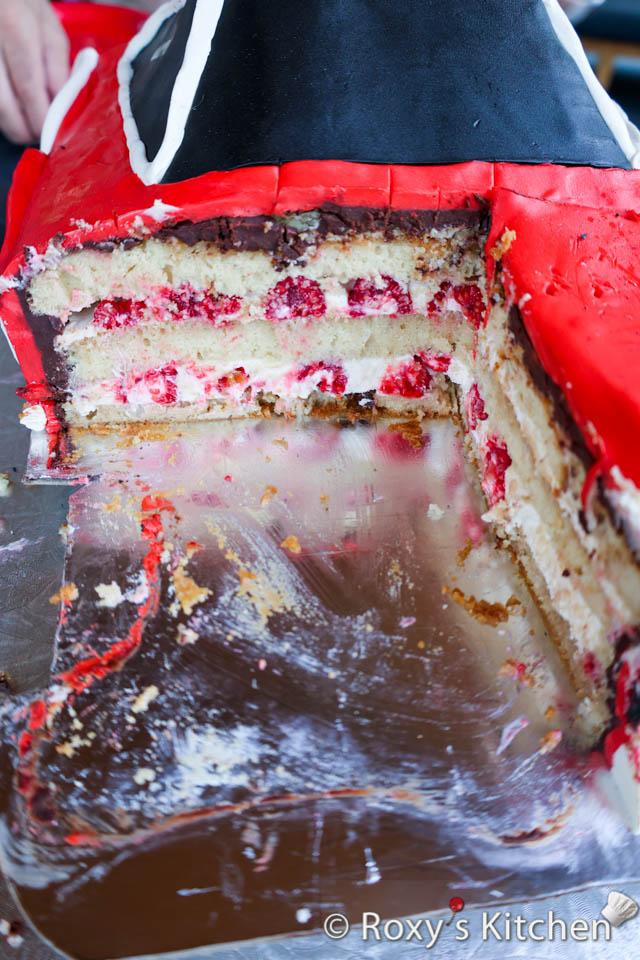
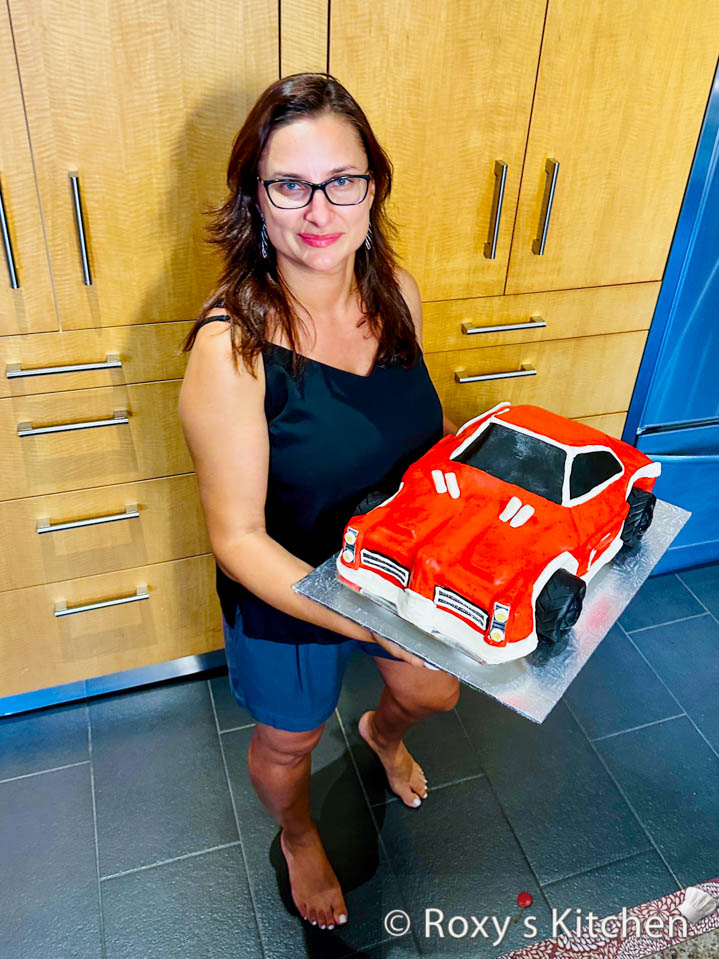
You might also like…
Race Car Cake with Remote-Controlled Headlights





























